

| Trade log-in: | HERE | |
| Get password | Forgot password | ||

2015.3 | 2015.2 | 2015.1
2014.3 | 2014.2 | 2014.1 | 2013.3 | 2013.2 | 2013.1 | 2012.3 | 2012.2 | 2012.1
2011.3 | 2011.2 | 2011.1 | 2010.3 | 2010.2 | 2010.1 | 2009.3 | 2009.2 | 2009.1
2008.3 | 2008.2 | 2008.1 | 2007.3 | 2007.2 | 2007.1 | 2006.3 | 2006.2 | 2006.1
2005 | 2004 | 2003 | 2002 | 2001 | 2000
This month, coming on the heels of President Obama’s executive order extending the U.S. ban on Burma jade and ruby, we include three items on Burma’s gemstones and gemstone industry.
We should remind our readers that Pala International’s Bill Larson will be speaking on “The Mythic Valley of Mogok” on September 6, 2013, in Paris, as we mentioned last month. On the eve of the Colorado Mineral & Fossil Show, September 10, 2013, Bill will give a similar presentation, “Mogok: The Mythical Valley of Gems,” at the bi-monthly meeting of the GIA Alumni Association, Mile High Chapter. A light supper begins at 6:30 at the Gold Buyers of Lakewood, 8830 West Colfax Lakewood, CO 80215. Cost is $20 for non-members, $10 for members (membership is only $25 and is open to all Coloradans, even non-GIAers). RSVP to chapter president Michelle M. Rahm.
 |
The 3rd Annual Dallas Mineral Collecting Symposium is scheduled for August 23 and 24. The event kicks off with a Friday night cocktail party at the Perot Museum of Nature and Science.
The symposium itself takes place on Saturday at Southern Methodist University’s Cox School of Business. Pala International’s Bill Larson will speak on “40 Years at the Himalaya Mine.” The tentative list of speakers:
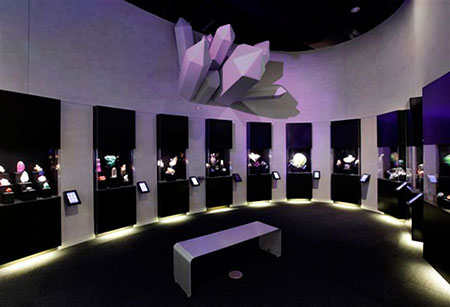 |
| A view of the Lyda Hill Gems and Minerals Hall, in the still-new Perot Museum of Nature and Science. In his report on a January 2013 to the museum, Bill Larson wrote, “I did note that there were no gemstones on display as of yet and was told that they’re hoping for a similar outreach into the community, and perhaps even farther, for persons who would loan exceptional gemstones to help expand the Lyda Hill Hall of Gems and Minerals.” Hint, hint. (Photo: Mark Knight Photography) |
[back to top]
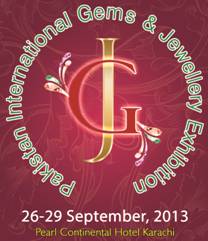 |
The Pakistan Gems and Jewellery Development Company (PGJDC) is sponsoring PIGJE 2013 (Pakistan Interntational Gems & Jewellery Exhibition) at the Pearl Continental Hotel in Karachi, September 26–29, 2013. The exhibition originally was scheduled for May.
The show will feature rough and cut gemstones, mineral specimens, jewelry, carvings and equipment.
Last year’s exhibition had 78 exhibitors from Pakistan. Forty delegates visited from Sri Lanka, U.A.E., U.S.A., E.U./U.K., Canada, France, Hong Kong and India. Ninety exibitors are expected this year.
In a brochure that accompanied its exhibition invitation, PGJDC provided the following industry information.
More information is available at the exhibition website.
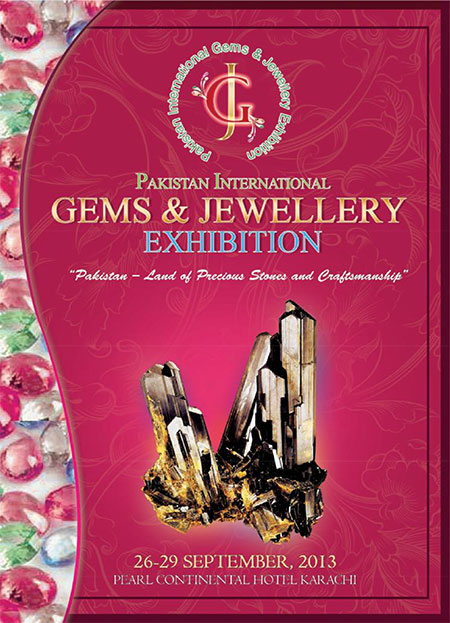 |
| The exhibition brochure features a fine epidote crystal specimen on its cover. |
[back to top]
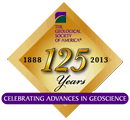 |
The Geological Society of America is holding its 125th Anniversary Annual Meeting and Expo in Denver, October 27–30, 2013. For the first time at a GSA meeting, GIA is sponsoring a topical session. “Gemological Research in the 21st Century: Characterizing Diamonds and other Gem Minerals,” featuring a powerhouse roster.
Scheduled for the session are James E. Shigley (GIA), Dona M. Dirlam (GIA), George R. Rossman (Caltech), George E. Harlow (American Museum of Natural History), William B. Simmons (University of New Orleans), Frank Hawthorne (University of Manitoba).
The description of the session reads: Gemstones are the most recognized, sought after, and highly valued of all minerals. This session will focus on characterizing the properties of gems, documenting their conditions of formation, and improving the means of their identification. [back to top]
We received the following report from Dr. Jayshree Panjikar of Pangem Enterprises, Pune, India.
This year De Beers celebrates the company’s 125th anniversary (1888–2013). Every year in the month of July for the last 64 years delegates attend the De Beers Diamond Conference in the United Kingdom. They come from various Universities likes Oxford, Cambridge, Cardiff, Wales, Warwick, Manchester, Bristol, Glasgow, Newcastle, Harvard, Alberta, Melbourne, Michigan, Jerusalem, Uppsala as well as from institutions like DTC Research Center, Element Six, HRD Antwerp, GIA New York, GIA Carlsbad, SSEF Switzerland, Institut Max von Laue, France; Max Plank Institute, Germany; Nuclear Physics Institute, Academy of Sciences, Czech Republic; Institute of Material Research, Hasselt University, Belgium; Kavli Institute of Nanoscience, Delft, the Netherlands; National Research Council of Canada; and research departments of companies like Sumitomo Japan and Hewlett-Packard USA. This year the 64th De Beers Diamond Conference took place July 8–11 at the University of Warwick, United Kingdom.
The conference began with a lecture by Prof. Dr. Julie Macpherson, University of Warwick, entitled “Diamond Electrochemistry and Sensors.” Keynote speaker Prof. Dr. J. Amussen, Michigan State University, spoke on an important current topic, “Microwave Plasma Assisted CVD Diamond Synthesis: Reactor Design and Associated Process Methods for Robust, Safe and Efficient Diamond Synthesis.” Other keynote speakers were Dr. Emmanuel Fritsch from the University of Nantes, France, and Dr. R. W. N. Nilen of Element Six, Global Innovation Center, Harwell, UK. Dr. Fritsch gave a very interesting presentation on the morphology of natural and synthetic diamond crystals.
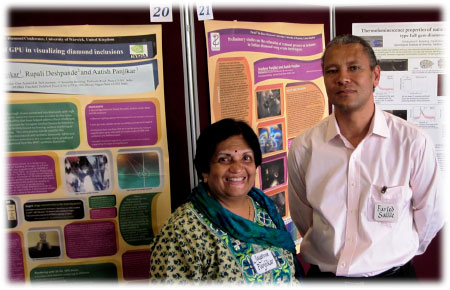 |
| Mr. Faried Sallie, Head of Technology, De Beers Group, discussing with Dr. Jayshree Panjikar the commercialisation of the techniques presented in her papers. |
From HRD Antwerp, Dr. Bill Willems spoke on the optical defects in gem quality CVD synthetic diamonds measured by Raman-photoluminescence spectroscopy, whereas, from GIA New York, Dr. Ulrika F. S. D’Haenens-Johansson gave a presentation called “CVD Synthetic Diamonds from Scio Diamond Technology Corporation.” Thomas Hainschwang, of GGTL Liechtenstein, deliberated on the origin of colour in C-center containing natural diamonds. Christopher Breeding, of GIA Carlsbad, presented a paper on the thermoluminescence properties of natural and HPHT-treated type IaB gem diamonds. From India, Dr. Jayshree Panjikar and Aatish Panjikar of Pangemtech – Panjikar Gem Research & Tech Institute, Pune, presented two technical papers, one on “Preliminary studies on the estimation of remnant pressure on inclusions in Indian diamond using strain birefringence” and the other in association with Rupali Deshpande of Nvidia, India, on the “Application of GPU in visualizing diamond inclusions.” The first paper would be of importance in the cutting and faceting of diamond whereas the second would help in the identification of synthetic and natural diamonds.
In all, 61 technical papers were presented on various scientific and technological aspects of natural and synthetic diamond. Unlike other conferences, it brought together a wide range and variety of disciplines involved with diamond, viz. chemists, electronic-engineers, geologists, geoscientists, gemmologists, physicists, nanotechnologists and academicians working on fundamental science as well as technologists developing new applications of diamond. [back to top]
This month we feature an exceptional red beryl from the Wah Wah Mountains of Utah. This fine blood-red jewel weighs in at 2.44 carats, which by red beryl standards is huge, especially in a fine quality piece. The red beryl crystals come out of the ground in small, mostly included elongated hexagonal prisms. It’s very rare to even find small gemmy sections with which to cut moderately clean stones.
 |
| Red beryl from Utah, 2.44 carats, 9.98 x 7.85 x 4.16 mm. Inventory #21250. (Photo: Mia Dixon) |
This particular gem was cut out of a crystal that Pala sold in the 1970s, which we recently bought back in the interest of using it as gem rough. Even though the crystal was very fine, the gem value far exceeded the specimen value. In the end, luckily we came out with a completely natural unoiled 2.44-carat emerald cut that would rival ruby for color and go way beyond, rarity-wise. Pala also purchased a few smaller crystals as well, so we have a good bit of a selection of these unique little red jewels right now.
Interested? Select the inventory number above, call (phone numbers below) or email us to inquire. [back to top]
Burma’s Mogok Stone Tract is known for more than red and blue corundum. Many thousands of carats of green peridot also are produced. Burma also can produce gem-quality diopside of a lovely green. But when thinking of other Burma greenies, alexandrite or green chrysoberyl might not come to mind.
The current edition of Australian Gemmologist (2013, 25[2], 41–45) features a study of just this latter material—at least it appeared to be vying for the alexandrite moniker. In “Vanadium- and chromium-bearing chrysoberyl from Mogok, Myanmar – an examination of two historical samples,” authors Dr. Karl Schmetzer, Dr. Heinz-Jürgen Bernhardt and Christopher Cavey explain why “alexandrite” did not figure in the title of their study.
The authors begin by noting that “bright green chrysoberyl, termed alexandrite” is a rare and pricey gemstone in general. Samples from Myanmar are even rarer. Thus, most of the material from that country with which the authors have come into contact is “only slightly yellowish green or greenish yellow.” This is compared with the description by C. J. Payne (“An alexandrite crystal from Burma,” The Gemmologist, 1956, 25[296], 39–40) of a crystal from Mogok that exhibited a pleochroism different from that observed in Russian alexandrite of the time. The crystal was supposed to have come from Pain’s collection, which is housed at London’s Natural History Museum.
In the present study, the authors looked at two samples thought originally to have been in the collection of the gemologist and collector A. C. D. Pain.* The first is from the collection of coauthor Christopher Cavey, originally in the Pain Collection, obtained via dealer Max Davis’s exchange from the aforementioned Natural History Museum. It is an .08-carat faceted chrysoberyl that is “bright and intensely bluish green” in daylight. In incandescent light, however, it does not display the classic alexandrite color change, but rather a greenish blue. The second sample, a rough weighing 1.05 carats was observed by Dr. Schmetzer while working with alexandrites and chrysoberyls from a variety of localities, also at the Natural History Museum. It’s possible but not certain that this particular sample also may be from the Pain Collection, having been obtained by Davis as well. The authors’ study, which revealed “matching properties,” led the authors tentatively to assume that the samples came from Mogok, perhaps from the former Pain Collection, since they were obtained by the same dealer.
The rough crystal (above right) is broken at both ends and greatly distorted. Nevertheless, observation via immersion microscope of growth zoning and associated color zoning allowed the authors to reconstruct the broken terminations and create an idealized diagram of an intact crystal (A below). Using the description of the sample that Payne wrote up in 1956, the authors crafted a second diagram of that crystal (B below). Both diagrams display thick tabular habit after b, with larger a pinacoids.
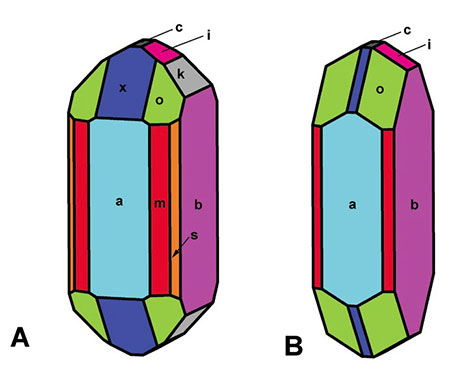 |
| Idealized crystal drawings (clinographic projections) of two chrysoberyl crystals from Myanmar in the same orientation; A sample from Natural History Museum, London, examined in this paper, B sample described by Payne (1956); both samples reveal thick tabular habit after b, with larger a pinacoids. Crystal drawings by K. Schmetzer. |
The authors’ small faceted sample turned out to be twinned, as observed via an interference pattern revealed under immersion with crossed polarizers. Unlike the rough sample, the faceted crystal did not accommodate an idealization diagram, due to its being cut from a larger sample.
The pleochroism of both samples in transmitted light was identical. For observation of the phenomenon in the rough sample, optic axes orientation was obtained easily due to its known morphology. Not so for the faceted sample; its pleochroism was seen only after orientation under the immersion microscope. Results are in the following table.
| Pleochroism of chrysoberyl from Mogok area, Myanmar, in polarized light. | ||
| Daylight | Incandescent light | |
| X || a | Pale yellowish-greenish gray1 Grayish violet2 |
Pale purple1 Red orange2 |
| Y || b | Yellowish green3 | Yellowish green3 |
| Z || c | Intense bluegreen3 | Intense bluegreen3 |
| 1 path of light 3.1 mm 2 path of light 6.6 mm 3 for various path lengths of light |
||
This pleochroism is not typical “alexandrite effect,” which would see remarkable color change in the X and Y directions. These results do, however, conform with the description of the Mogok crystal by Payne (1956). And the results cannot lead one to assume, according to the authors, that the phenomenon in the two samples “originate from the same source with similar colour causes and trace element contents.” Further, the authors questioned whether these trace elements could explain their spectroscopic properties.
The authors’ microprobe analyses of the faceted sample showed it to be a chrysoberyl with higher vanadium than chromium contents (0.38 wt% V2O3, 0.24 wt% Cr2O3). Analysis also revealed a distinct trace element zoning that corresponded with the sample’s observed color zoning. The rough sample returned similar results using X-ray fluorescence spectroscopy. These results were compared with other natural and synthetic chrysoberyl containing varying ratios of vanadium and chromium. Had there been no chromium in the authors’ samples, no color change would have been observed between daylight and incandescent light. Had the chromium:vanadium ratio been roughly equal, the bright green in daylight would have changed to “pale grayish green, almost colourless” in incandescent light. The authors found that, in their samples from Myanmar, the chromium component was dominant for the spectrum with X polarization; thus the chromium component in the spectrum caused the color change in that direction.
The authors conclude that the two samples in this study are believed to be from the same source in Mogok as that described by Payne (1956). But they should not be called alexandrite because they do not display the classic alexandrite-effect color change between daylight and incandescent light.
* See “Painite Comes to Pala” in which Pala International’s Bill Larson reminisces about his “romance” with the material that bears Pain’s name and which comes nearly exclusively from Mogok.
[back to top]
In the following essay, scholar Richard W. Hughes reflects on his recent week in Burma’s famous locales of Mandalay and Mogok. Saddened but not surprised by what he saw, Hughes points to clouds on the horizon—and to an escape route. We invite our readers to respond. Any responses will be published in the next edition of Palagems Reflective Index. Send replies to the editor.
For anyone with an interest in minerals and precious stones there are certain localities that epitomize the word “classic.” These represent not simply coordinates on a map, but transcendental intersections where Mother Nature’s majesty meets the history of humankind. Sar-i-Sang, Ratnapura, Golconda, Potosí, Chivor and Kimberly are but a few.
When it comes to ruby and sapphire, there is no more iconic locality than Myanmar’s Mogok Stone Tract. Off-limits to foreigners for more than 40 of the past 50 years, the door has once again opened a crack.
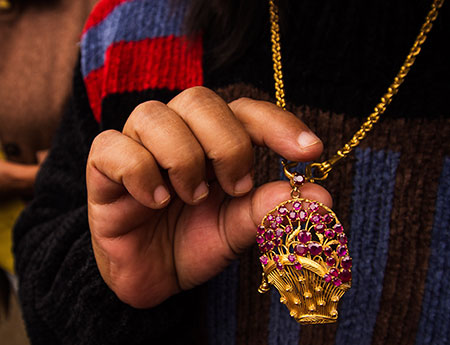 |
| Ruby-studded necklace in a gem market at Kyatpyin in Myanmar's Mogok Stone Tract, July 2013. Click to enlarge. (Photo: Billie Hughes) |
Wilawan Atichart, recently retired director of the Gem and Jewelry Institute of Thailand, accompanied by ruby and sapphire expert Richard Hughes, and his wife Wimon and daughter Billie, just spent a week in this storied locale. Despite the monsoon rains, we were able to visit a number of Mogok’s most important locales, as well as the major gem-trading markets.
What we found was a region that has undergone significant change since my last visit in 2004. Where small miners were once spread across the Tract, consolidation of claims in the hands of larger companies has forced many locals out. There is little question that this is due, in part, to the disastrous U.S.-led Myanmar embargo against ruby and jade. Within the shadow of darkness, abuse is free to flourish, and Myanmar’s gem mines are a classic example. The embargo left a vacuum where naked greed could grow unabated. In both Khotan (Xinjiang, China) and the Hpakan region of Upper Burma, deposits of jade that had been worked for millennia were subjected to modern mining methods that quickly ravaged once-timeless resources.
And now those same forces are being brought to bear on what I would argue is the planet’s most singular source of colored gemstones—Mogok.
 |
| Mechanized ruby mining operation at Chaunggyi in Myanmar's Mogok Stone Tract, July 2013. Click to enlarge. (Photo: Billie Hughes) |
In my three-plus decades in this business, I have visited more than sixty countries and dozens of locales for ruby, sapphire, spinel, jade and a variety of other gems. I am not alone in this. Many of my trade and gemological colleagues have done likewise. I think I can speak for all when I say that Mogok is as unique as Agra’s Taj Mahal, as iconic as the Kathmandu Valley or Egypt’s pyramids. Each of the above is a World Heritage Site. I believe that Mogok, with its precious mixture of history and culture is worthy of the same elevation and the same protection.
Today, the world’s premier gem locality is under attack. Surely if we can protect other classic monuments, both natural and human-made, then the gem and mineral community could come together to ensure that this most special place can be similarly preserved.
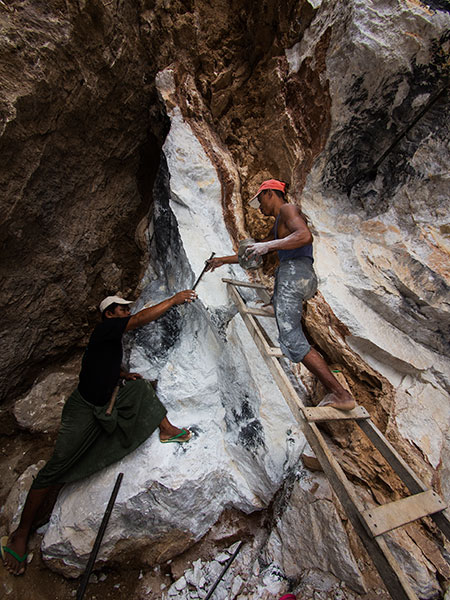 |
| Workers setting dynamite charges at Burma’s Sagyin ruby mines, July 2013. Note the clay band in the marble. It is thought that this clay provided the alumina necessary for the formation of ruby and spinel. (Photo: Billie Hughes) |
Several Mogok residents sought me out during my recent visit, asking for help. They understand too well that there are storm clouds over Rubyland. And they are pleading for our help.
This industry has long fed off the fruits of Mogok. Now is our chance to give back. In doing so, we would not only provide the residents of Mogok with a chance to preserve their storied ways of life, but save a vital part of human history, a rare intersection between Mother Nature’s and Man’s majesty. Will it make a perfect world? Not hardly. But if we wait five or ten years, this most precious repository will be emptied not just of its gem and mineral wealth, but of its human dignity.
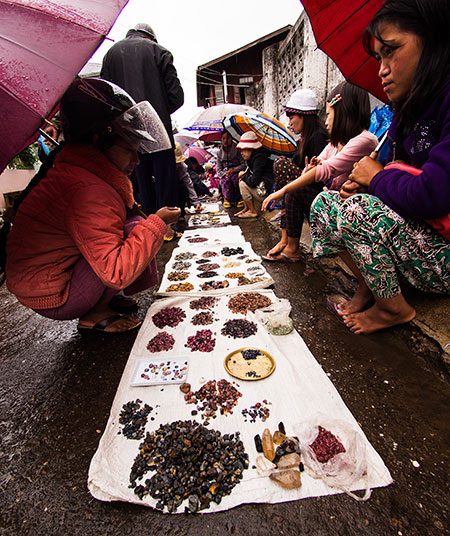 |
| Vendors offer rubies, spinels and a plethora of other gems at Mogok’s morning cinema gem market, July 2013. (Photo: Billie Hughes) |
Over the centuries, Mogok’s residents have come from far and wide. India, China, Nepal, even Great Britain, in addition to the ethnic groups from Myanmar proper. For generations Mogok has captivated and captured so many, all of whom today stress that, no matter what their ethnic makeup, they are from Mogok. Do we really want to turn these proud people into Walmart wage serfs, simply to justify a decade or two of corporate profits?
Myanmar’s recent history is a tragedy on so many levels. Here’s a chance for our industry to right some wrongs. Mogok will soon go the way of Hpakan and Khotan. If we act now, we might actually save perhaps the single most iconic gem locality on the planet.
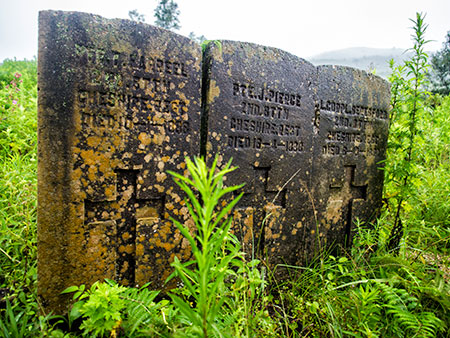 |
| Graves of British soldiers from 1888 at Bernardmyo in Myanmar’s Mogok Stone Tract, July 2013. (Photo: Richard W. Hughes) |
[back to top]
 |
| Buy blue. Let this dark blue natural Burmese sapphire catch the last rays of summer. Inv. #14683. (Photo: Mia Dixon) |
Echoing Richard Hughes, above, a Burma parliament member last week was quoted by Eleven Media Group (EMG) as saying that the jade mining area of Hpakant, in Kachin State, could disappear within thirty years.
Hla Sai is an MP with Aung San Suu Kyi’s National League for Democracy party, who has lived in the area for forty years. He told EMG that already more than fifty or sixty mountains in the area have “disappeared” and that only about ten remain. For years, inhabitants have complained that mining has caused flooding, with rivers and streams choked by mining debris.
The chair of a local Buddhist association, Vayama, compared Hpakant with Mogok, fearing that when the jade becomes rarer people will move out. He called for a return to artisanal mining and for government regulation.
Two days ago, the country’s Vice President Dr. Sai Mauk Kham listened to resident complaints, as reported in another EMG story. The Vice President responded by saying that the government will ban new companies and any with expired licenses from operating in the area. He said the government is in the midst of drafting new jade mining legislation.
Even though, as we noted in June, an extension of the U.S. ban on the import of Burma rubies and jade was no longer backed by its original sponsor, Senate Minority Leader Mitch McConnell, President Obama felt compelled to do so. Oddly, as reported by JCK, the U.S. Campaign for Burma, which supports the ban, stated that there wasn’t much opposition to the extension in Washington.
The government statement regarding the ban reads, in part,
However, due to continuing concerns, including with respect to labor and human rights in specific sectors, this Executive Order reinstates the prohibitions and restrictions on the importation into the United States of jadeite and rubies mined or extracted from Burma, and on articles of jewelry containing them, that was originally imposed by the Tom Lantos Block Burmese JADE (Junta’s Anti-Democratic Efforts) Act of 2008, which amended the BFDA. The Administration is maintaining restrictions on specific activities and actors that contribute to human rights abuses or undermine Burma’s democratic reform process.
This is received with some irony. As Richard Hughes states in his essay above,
Where small miners were once spread across the Tract, consolidation of claims in the hands of larger companies has forced many locals out. There is little question that this is due, in part, to the disastrous U.S.-led Myanmar embargo against ruby and jade.
As former British Ambassador to Thailand, Derek Tonkin, pointed out five years ago, and again in April, sanctions did one thing very well: the obliteration of constructive engagement via business, aid and tourism.
Read the text of President Obama’s executive order here.
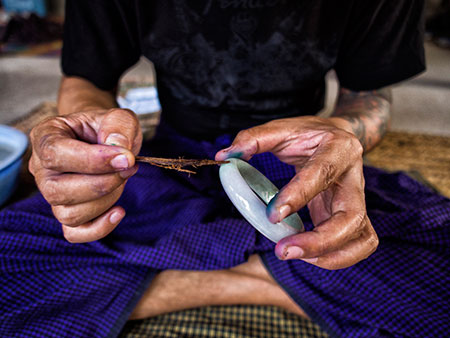 |
| Dying jade in Mandalay, August 2013. (Photo: Richard W. Hughes) |
[back to top]
Both BBC and Bloomberg did a little diamond-dissing in recent industry coverage. In “Diamonds lose their sparkle,” sporting an image of the Duchess of Cambridge wearing the now iconic sapphire of her late mother-in-law, BBC wrote that the price of rubies and sapphires is rising faster than that of diamonds. And who is buying? Asians. And women, who go for color, whereas men go for no-muss-no-fuss ice. This, according to Diamond Manufacturers founder Vashi Dominguez, in the tony Hatton Garden jewelry district of London.
Bloomberg included this tag line below its short video on jade: Forget Diamonds, Asia’s Wealthy Invest in Jade. For instance, a jadeite ring that sold at Christie’s in May for five times its pre-sale estimate. The article accompanying the video cites Shanghai’s sluggish stock market as a force behind bankrolling bijoux. Demand for jadeite is outrunning supply of the material, 90% of which comes from Burma, according to the article.
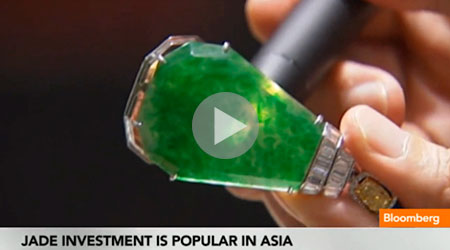 |
[back to top]
French Connection Films has released a documentary that takes the viewer into the ateliers of a baker’s dozen of the world’s top jewelery designers. Masters of Dreams spends an episode apiece on the work of Italians, French and Swiss, English and South African, and “jewelers of the Americas.” Along the way, five events are visited: Christie’s auction of the Elizabeth Taylor Collection in New York (December 2011), Bulgari’s “125 Years of Italian Significance” retrospective in Shanghai (February 2012), the 65th annual Cannes Film Festival (May 2012), the London Masterpiece Fair (July 2012), and the Biennale des Antiquaires in Paris (September 2012).
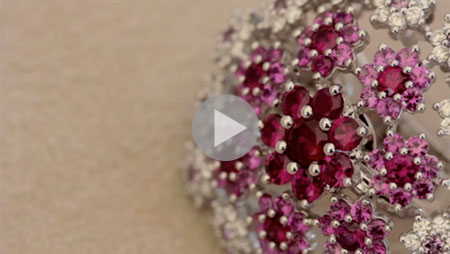 |
The documentary is available from the producers’ website. [back to top]
 |
Okay, now close your eyes.
In “Letting Out the Light,” award-winning gemologist and documentarian Stephen Henry Gill travels far and wide, gathering the sounds of mining and the voices of gemstone cutters as they explain their work. He also time-travels, back when and not so long ago. [back to top]
With Pala Presents, we offer selections from the library of Pala International’s Bill Larson, who will share with us some of the wealth of information in the realm of gems and gemology.
This month we offer articles spanning fifty-five years. The first is an overview of rubellite and lepidolite in Southern California, by Harold Wellman Fairbanks (1860–1952). Fairbanks went on to publish perhaps two dozen books and authored more than forty articles as an expert on the geology and geography of the Pacific Coast. In 1907 he contributed to a book about the devastating California earthquake the previous year, which destroyed more than eighty percent of San Francisco. In 1920, World Book (of the famous encyclopedia) published his Conservation Reader, aimed at educating young people. We have illustrated his article on rubellite with lovely examples from the Pala International lightbox.
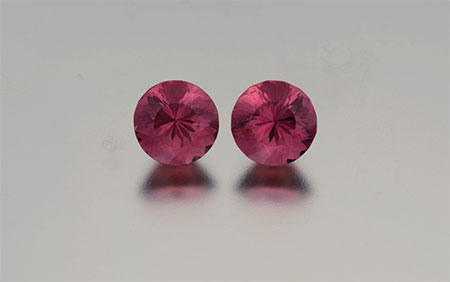 |
| From the Himalaya Mine. A matched pair of rubellite rounds, 8.68 tcw. (Photo: Mia Dixon) |
Our second article, from 1918, is yet another survey of the gemstones of California. Its author, Alice M. Keatinge, appears to have lived in Northern California and to have written on various subjects. She also seems to have dabbled in watercolors. In 1912 she copyrighted a four-act play, Wawona; or, California, and in 1929, the lyrics to a song “Blossom Time in San Jose.” The variety of California gemstones, described by Keatinge, is complemented with illustrations of kunzite, natural blue topaz, benitoite, morganite, and carved tourmaline, again from the Pala lightbox.
Richard H. Jahns (1915–1983), who wrote the third in our trio of articles, was Stanford’s Dean Emeritus of the School of Earth Sciences and Welton J. and Maud L’Anphere Crook Professor of Geology and Applied Earth Sciences. The school’s obituary for Jahns states,
His many field trips for students over the years to Death Valley, to the Pala and Ramona Pegmatite Districts of Southern California, and to other points in the Western U.S. became legendary because of Dick’s ability to stimulate interest, to teach, and to leave all participants with the feeling that this gentle man really knew and loved his craft.
His article on Southern California gem deposits is accompanied by several photographs and diagrams that take you into the gem-bearing earth of San Diego County.
[back to top]
The following appeared earlier this month in our sibling publication, Pala Mineralis.
With Pala Presents, we offer selections from the library of Pala International’s Bill Larson, who will share with us some of the wealth of information in the realm of minerals and mineralogy.
With this edition of our newsletter we are pleased to offer a reprint of an study by Slovenian scholars Miha Jeršek & Breda Mirtič of corundum from the dolomitic marble of Prilep in central southern Macedonia, part of the metamorphic rocks of the Pelagonian Massif, which stretches from the capital Skopje southeast to the Aegean Sea. The authors describe corundum from Prilep marble in a wide variety of forms, some of them for the first time. One such morphology is diaspore intergrowth. The light reflected from diaspore lamellae, described as a “silverly-white glittering,” is a phenomenon “unique in the world of gemstones,” according to the authors, “and we have named it “diasporescence.”
Read “Corundum from Prilep Dolomitic Marble (Macedonia)” here.
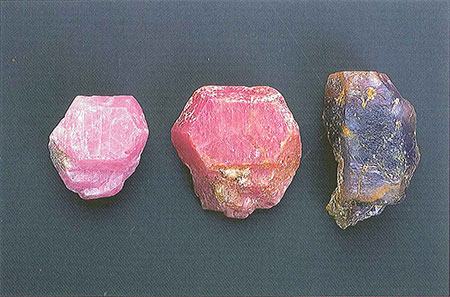 |
| Spectral. Characteristically pink and red coloured corundum crystals. Prismatic crystal on the right is blue coloured and is rarely found in Prilep marble. Its height is 3.0 cm. |
[back to top]
— End August Newsletter • Published 8/15/13 —
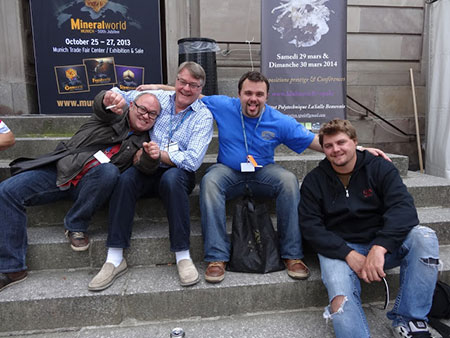 |
| Q: What’s in the bag? Left-to-right, Laurent Thomas and Pala International’s Bill, Will and Carl Larson clown around at the 50th Sainte-Marie-aux-Mines show, on the steps of the theater, the show’s premier venue. For more on the show, see the Natural History Museum of Los Angeles County’s MinBlog, and the report by Eloïse Gaillou, the museum’s associate curator of mineral sciences. A: Serious crystals. (Photo: Eloïse Gaillou) |
Pala International heads to the East Coast later this summer for the trade-only JA New York Summer Show. Stop by to see one of America’s largest selections of fine colored gems.
 |
See this list of seminars to be held at the show.
When: July 28–July 30, 2013
Where: Jacob K. Javits Convention Center
Hours: AGTA Gemstone Section
Sunday, July 28: 10:00 AM – 6:00 PM
Monday, July 29: 10:00 AM – 6:00 PM
Tuesday, July 30: 10:00 AM – 4:00 PM
Pala International is in booth 2581. See the JANY website for more information. Visit the Pala International Show Schedule for future events. [back to top]
On the heels of current exhibitions at the Bowers Museum—The Tsars’s Cabinet and Gems of the Medici—plan to be wowed once more. “Jewels of the Connoisseur” shines the pin spot on the collection of Buzz Gray and Bernadine Johnston. From the press release:
Gray and Johnston have played many roles in the world of gems and jewelry including miner, gem and mineral dealer, gem cutter and jewelry designer. Their collection of little known gems has grown over the years to include species such as jeremejevite from Namibia, sphene from Pakistan and Madagascar, scheelite from China, stibiotantalite from Mozambique and black opal from Nevada. Together they have crafted these and other rare stones into familiar jewelry and art presentations in order to introduce and celebrate the world of rare stones to a wider audience. Because the stones are naturally produced in limited quantities they rarely, if ever, find their way to the broader commercial market. Some of the gems presented in Jewels of the Connoisseur are indeed so rare that even avid gem collectors are unable to own them.
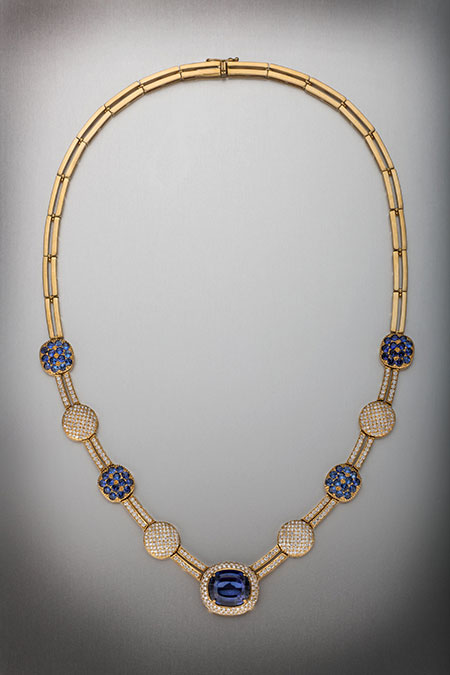 |
| Benitoite necklace. The center stone is a 5.55-carat benitoite cushion accompanied by 3.03 more total carats of the stone, along with 2.55 carats in diamond. (Photo: Robert Weldon, courtesy Bowers Museum) |
In addition to the “fifty works of art and brilliant jewelry settings” in the exhibition will be the world’s largest known gem-quality faceted morganite, weighing 1,377 carats. Each of the settings was created by Bernadine Johnston from gems cut by Buzz Gray. We find this exhibition to be of personal interest: Buzz Gray worked for Pala International between 1971 and 1977, setting up our lapidary as well as expanding the corporation’s rare gemstone business. And Bernadine Johnston retired as manager of The Collector Fine Jewelry in 1982.
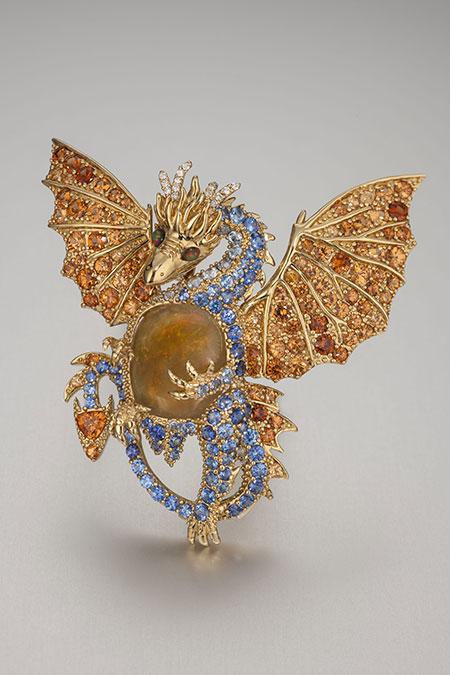 |
| Dragon pendant. The body of this wild and fabulous creature is a 21.09-carat opal from Nevada. The wings are encrusted with 11.90 carats of spessartine, the limbs, neck and tail with 6.23 carats of soft benitoite. (Photo: Robert Weldon, courtesy Bowers Museum) |
The exhibition opens July 27, 2013. The museum is open extended hours on Thursdays during through September 12. See the Bowers Museum website for all the details.
Heck, just plan an extended stay in Southern California so you can catch the three Bowers shows as well as an exhibition at GIA that opens this coming October 10. “More is More: Tony Duquette & Hutton Wilkinson Jewelry” is the first all-jewelry exhibit for these Hollywood designers. Duquette is the only American to have had a one-man show at the Louvre. He worked with his collaborator Wilkinson for 30+ years prior to the latter’s death in 1999. Their clients included Duchess of Windsor, Doris Duke, Buddy Rogers, J. Paul Getty and Elizabeth Arden, according to today’s press release. Madeleine Albright would be envious…
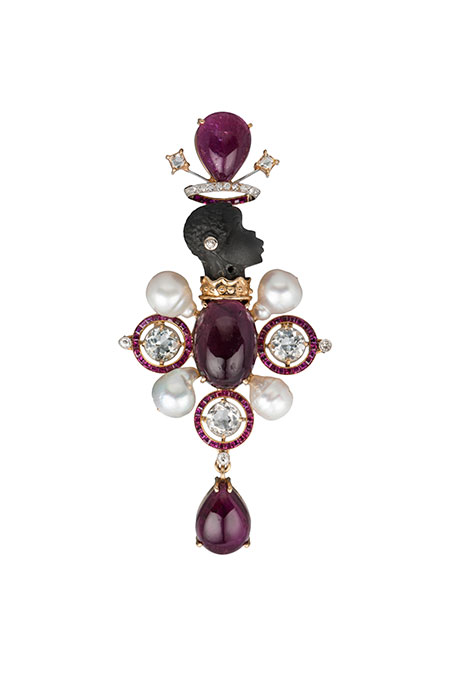 |
| “Othello” Brooch. Ruby, diamond, South Sea cultured pearl and tourmaline blackamore “dressed figures” are a mix of modern and ancient designs. (Photo Copyright GIA) |
[back to top]
 |
The 3rd Annual Dallas Mineral Collecting Symposium is scheduled for August 23 and 24. The event kicks off with a Friday night cocktail party at the Perot Museum of Nature and Science.
The symposium itself takes place on Saturday at Southern Methodist University’s Cox School of Business. Pala International’s Bill Larson will speak on “40 Years at the Himalaya Mine.” The tentative list of speakers:
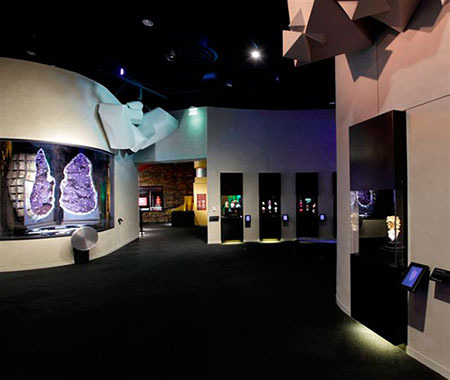 |
| A view of the Lyda Hill Gems and Minerals Hall, in the still-new Perot Museum of Nature and Science. (Photo: Mark Knight Photography) |
[back to top]
Powellite is more commonly seen in the mineral world, but these fine faceted stones bridged the gap into the gemstone side. These neon golden jewels are not only rare but radiate a beautiful glow. Stunning orange-yellow to greenish-yellow hues, with some dispersion, bringing them into a state that would be difficult for a sight ID. This is certainly some of the finest powellite we have ever seen, maybe even some of the finest the world has ever seen.
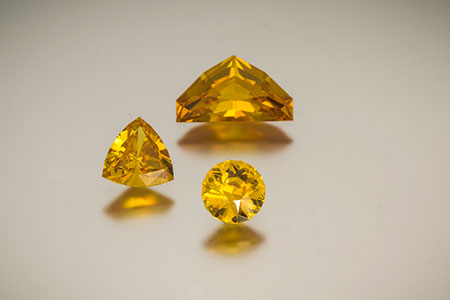 |
| Powellite from Tanzania. Inventory #21167, 5.62-carat shield; Inventory #21168, 2.98-carat round; Inventory #21174, 2.90-carat trillion. Click to enlarge. (Photo: Mia Dixon) |
These unique powellites were discovered in the Mahenge region of Tanzania, near the deposit of fine pink and reds spinels we have all come to covet. Originally thought to be scheelite, the material later on was correctly identified as powellite. Powellite does form a solid solution series with scheelite, but powellite is a calcium molybdenum mineral whereas scheelite has a calcium tungsten makeup.
Interested? Select the inventory numbers above, call (phone numbers below) or email us to inquire.
 |
Many of our readers know that Pala International is a family affair, with Bill Larson running the show and Jeanne Larson helming The Collector Fine Jewelry. Sons Will and Carl also are involved, with Will having launched the Palaminerals enterprise and Carl recently receiving his Graduate Gemologist credential from GIA.
So it was a little strange when a fifth Larson, going by the name of “Steve,” fell from the family tree. (Larsons are not that easily replicated.) When this impersonator requested inventory to be shipped to a hotel in West Virginia, savvy clients of Pala International became suspicious enough to contact us.
So, seller beware, and err on the side of caution if you suspect foul play. Call us at 800-854-1598. [back to top]
Last week, Pala International’s Bill Larson appraised the gemstone collection at the Mineralogical and Geological Museum at Harvard University. Bill was chosen by the museum’s associate curator, Dr. Raquel Alonso-Perez, to appraise the collection’s 1,200 pieces. The first day just over 500 pieces had been examined with two more full days to follow. “Raquel couldn’t believe how focused I was when looking at the gems,” Bill told us. Many special notes were documented. Bill reported that a good feeling emanated from all those involved.
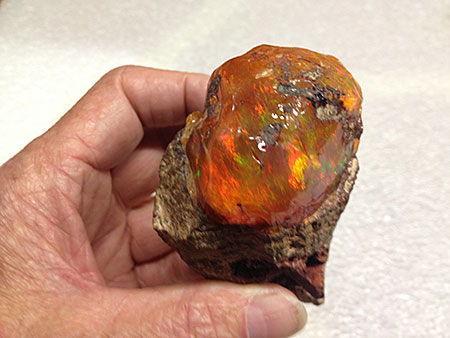 |
| “For those who do not know,” Bill Larson explains, “fine Mexican opal lasts!” This opal nodule, in rhyolite matrix, contains goethite inclusions. From the Iris Mine, Hacienda Esperanza, Queretaro, Mexico. Gift of James A. Garland, 1892. (Photo: Bill Larson) |
“They did the heavy lifting—organizing the list (name, carat weight, locality, and other details),” Bill told us. “I just have to appraise the wholesale value of each piece, providing particular notes on what should be retained and displayed, and what is not up to standard.” Bill said that going through and handling each gem, one by one, was a treat. And there often was a lot of history behind a given stone. “I was seeing pieces from George F. Kunz and Fredrick Canfield from the early 20th century. And later on, pieces from Fred Pough, Martin Ehrmann and special Larson friend John Sinkankas.”
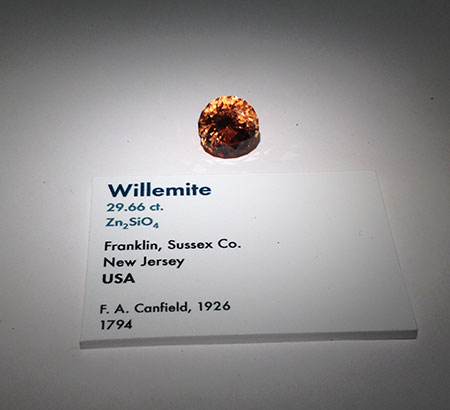 |
| To the Miner Born. Bill Larson loved coming into contact with gemstones from some of the great collectors of the past such as Frederick A. Canfield, from whom this willemite comes. The son of a mine superintendent—and born at the family mansion Ferromonte (iron mountain)—Canfield went into mining himself. The Canfield collection was built upon that of great uncle Mahlon Dickerson, who was Supreme Court Justice, Governor and Senator for New Jersey. Canfield bequeathed his mineral collection to the Smithsonian Institution. (Photo: Bill Larson) |
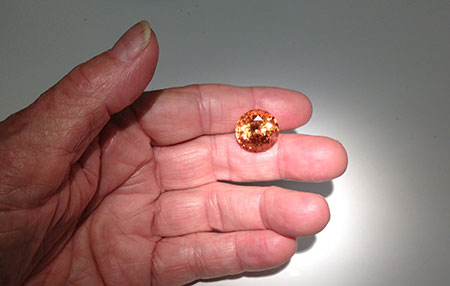 |
The museum has a very rich New England collection of various beryls, tourmalines, and rare gems such as beryllonite and purple apatites from Maine. Bill has extensive knowledge regarding locality gem collecting and already is familiar with the Harvard collection from various visits and lectures he’s given there over the past 35 years. “Raquel was surprised,” Bill said, ”at how many gems I knew from past contacts.”
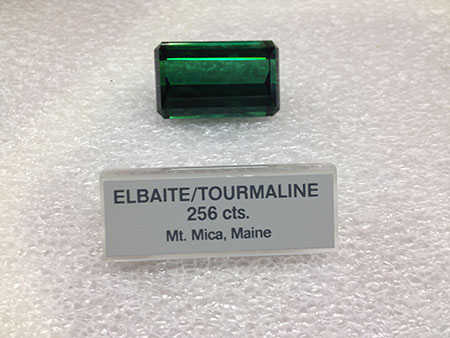 |
| That’s a big-e. This 256-carat tourmaline, from the Marion and Hadley Stewart collection, is the largest known to have been produced in Maine. “It’s valued at $1000 per carat,” Bill Larson said, “and worth every bit of that.” (Photo: Bill Larson) |
“My favorite piece,” he told us, “has to be the famous Hamlin tourmaline necklace which is priceless!” According to John S. White, who knows his way around a museum or two, most of the necklace’s eighteen major stones are from Maine’s Mount Mica Mine (the others are beryls from Massachusetts). Per the online magazine, Luxury Jewels 24, the necklace’s center stone—a 34.25-carat green tourmaline—was mined in 1886 by Augustus Choate Hamlin, son of Elijah Hamlin, who co-discovered the pegmatite in 1821. Augustus also was nephew of Lincoln’s Vice President Hannibal Hamlin and became Mayor of Bangor and Surgeon General of Maine.
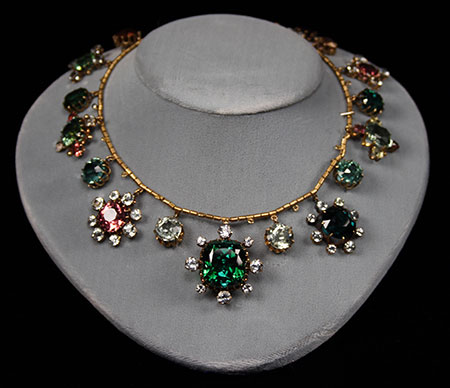 |
| The Hamlin Necklace. Some of Maine’s finest tourmaline is showcased in this necklace, which is on display at Boston’s Museum of Fine Arts through June 1, 2014. Maine’s first ladies are obligated to wear a more modest example on official state occasions (see “The Maine Event” on Palagems.com). Below, a loose pendant from the necklace, such as is pictured in Hamlin’s notebook below (click to enlarge). (Photos: Eva Barajas, Copyright MGMH) |
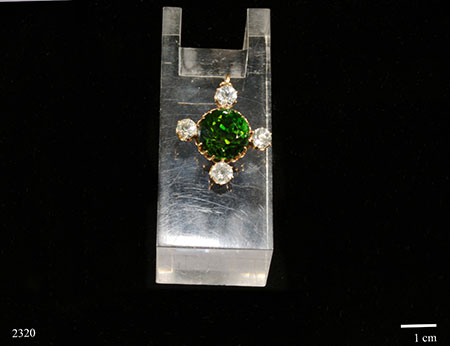 |
Augustus commissioned the necklace some time before donating it to Harvard in 1892. But, according to Maine jeweler Dennis Creaser, there is a second, “newly discovered,” Hamlin necklace, part of a suite called the “Parure of American Gems.” Creaser is able to date the “Parure” (a matched set of ornaments; French for “adornment”) to as far back as 1869. He also states that this necklace had “dozens” of interchangeable pendants that Hamlin employed to showcase gemstones from other localities.
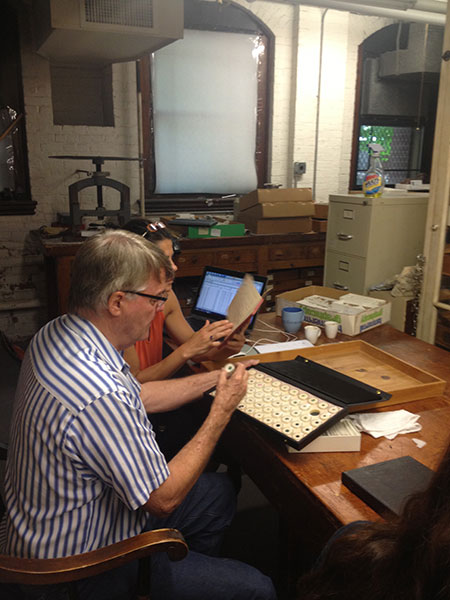 |
| Only 1150 to go… Bill Larson examines a fifty-piece set from the Hamlin collection at Harvard as Dr. Raquel Alonso-Perez consults Hamlin’s catalogue, pictured below. (Photo: Tracy Warmington) |
The benefits of a collection such as that at Harvard University are manifold: curatorial care, access for scholars, public exhibitions. But the fact is that the collection is almost entirely built upon the generosity of individuals. Prestigious as Harvard is, a budget for gemstone accessions is nearly nonexistent. After viewing the collection in its entirety, Bill Larson told us, “I noticed a severe lack of precious stones in the collection, including ruby, sapphire, emerald, black opal and spinel. Only a few decent examples of these gemstones are represented. Harvard (as well as most museums) are perfect recipients for a gift that could reward the donor of a fine stone with a hefty tax break. So if you’re wondering what to do with that pin you inherited with its 5-carat ruby: Think Harvard.” Interested parties can contact associate curator Dr. Raquel Alonso-Perez here.
The gemstone collection at Harvard also includes gemstone carvings, such as those shown below. Designed by Gerhard Becker, of Idar-Oberstein, they are crafted in Maine and Pala tourmaline, with 18-karat gold beaks and legs, perched on rock crystal. These were carved in the late 1970s.
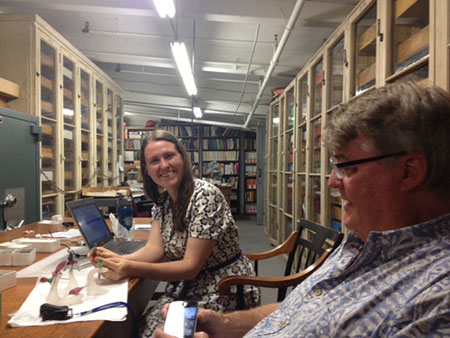 |
| Precious psittacines. Curatorial assistant Theresa Smith holds one of several aviamorphic carvings—parrots, to be exact—while Bill Larson appraises to the dulcet twitters of Pink Floyd. (Photo: Raquel Alonso-Perez) The parrots were sleeping when it came time for a proper photo session, but the roosters were a-crowing. (Carving: Gerhard Becker design; Photo: Eva Barajas, Copyright MGMH) |
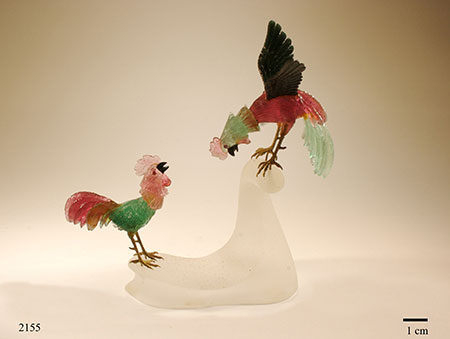 |
Pala International is commissioning a new miniature gem carving collection. Inspired by Gerhard Becker’s originals, these are being carved this year by master carvers in Idar-Oberstein, Germany. As with the Becker classics, this project employs special tourmaline rough pieces that Bill Larson has carefully selected for several decades from localities worldwide. The new collection will feature hummingbirds, parrots—and a few surprises.
The carving techniques, we are told, while similar to those of the past, have advanced to new levels of perfection in the last 40 years. Carl and Bill Larson met in June with the carvers following the show in Sainte-Marie-aux-Mines to discuss the project, which began last year. Pala hopes to show the first of these at the Tucson show this coming February. Gamini Ratnavira will be painting some of these finished objets d’art to add to the excitement. [back to top]
Just before summer turns to fall, Pala International’s Bill Larson is scheduled to present at the 13th Rendez-vous Gemmologiques de Paris, on September 6, 2013. It will be held in the grands salons of the CCI (Chamber of Commerce and Industry) Paris Ile-de-France located in the historic former Hôtel Potocki, 27, avenue de Friedland, 75008 – Paris, from 9:30 a.m. to 6:00 p.m.
 |
Information can be obtained from the sponsor, Association Française de Gemmologie, 7 rue Cadet, 75009 – Paris, gemmes7@wanadoo.fr. The organization celebrates its 50th year in 2013.
Three sessions are planned. In the colored stones session, Bill Larson will speak on “The Mythic Valley of Mogok,” Burma, source of the world’s famous rubies. The diamond session will feature expert David Fisher, and the pearls session will feature expert Nick Sturman. Also presenting at the conference is Eloïse Gaillou, Associate Curator of Mineral Sciences, Natural History Museum of Los Angeles County, who provided this month’s report on the Sainte-Marie show. She will present on “Pink and Blue Diamonds: Hits of the Market.” Here’s the complete subject-to-change lineup—received in easily translatable French at e-press time.
Diamonds
Ya’akov Almor: « Éthique et responsabilités du gemmologue dans la chaîne globale des pierres et de la joaillerie ».
Colored Stones
Pearls
[back to top]
We recently received some images of gem-like ice, recalling the “jade icebergs” we pointed to four years ago. These photographs, by German geoscientist and photographer Dr. Christian Klepp, are of highly pressurized glacial ice, containing almost no air bubbles. The ice absorbs all but the shortest blue fraction, putting the aquamarine in aquamarine. The images are from Svinafellsjökull glacier, Skaftafell, Iceland. Get all the science behind the phenomenon in the links below.
 |
| Entering the Enchanted Realm. This tunnel of ice from thousand-year-old snow is 164 feet long, 33 feet wide, and 6 feet tall. And it’s on the move—about a meter a day. All the details are here. (Photo © Dr. Christian Klepp) |
Dr. Klepp has published a book, in both English and German, LichtJahre [LightYears] – Where Geoscience Meets Art, available. The book covers quite a bit of ground, with images from Iceland to Turkey to New Zealand and more.
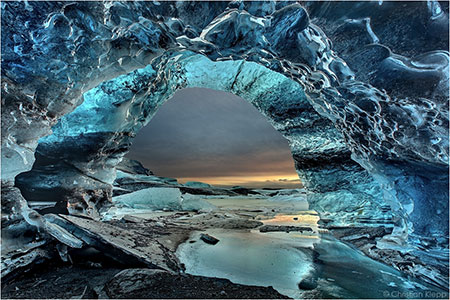 |
| The Crystal Grotto. This is an ice cave in Svinafellsjökull glacier where the outside temperature remains below 17°F for long periods. You will want to appreciate the Escher-like quality of the larger image (and the technical detail) here. (Photo © Dr. Christian Klepp) |
For more icy aqua, see the North Baikal images of Bratsk-based photographer Alexey Trofimov (El Barto), beginning here. [back to top]
On June 11, Sotheby’s London auctioned some of the jewels formerly owned by Princess Ceril Birabongse of Siam. Her birthstone was opal, and she had quite a collection given to her by the Prince, some of which is shown below, from a press release.
The sale more than met expectations. A lovely necklace of ribbon motifs, Lot 300, sold for over twice its upper pre-sale estimate of $7,500. The bracelet pictured below, Lot 301, sold for nearly three times its lower estimate of $7,500. An opal-and-diamond bracelet, Lot 299, doubled its upper estimate of $3,000. The larger (Lot 297) and smaller (Lot 298) brooches pictured below both went for three times their upper estimates of $4,500.
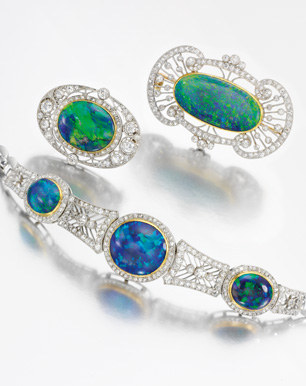 |
The Princess bride, Briton, likely was 21 when she married Birabongse “Bira” Bhanudej. The two appear to have met at Byam Shaw Art School in London, and they wed on January 12, 1938. (Her chum Elizabeth “Lisba” Hunter married the elder Prince Chula Chakrabongse, Bira’s cousin, who managed a racing team.) They divorced in 1949, only to remarry again in 1983 (after he had wed four more times). Prince Bira, as he was known, became an avid race-car driver, competing in Formula One, Grand Prix, and Olympic Games contests.
Some of the lore behind the jewels is included in a July 10 story in the Mail Online, but other details in the article contradict Wikipedia and this Thai source as well as Ceril’s memoir, The Prince & I: My Life with Prince Bira of Siam. [back to top]
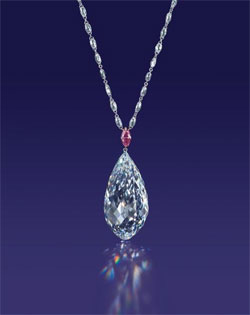 |
On May 28, Christie’s set a world record price for a briolette diamond sold at auction. It sold midway between its pre-sale estimate of $8.5 to $12.5 million, but it still achieved the world record, coming in at $11,151,245, or $148,000 per carat.
The new owner—and new name—of the jewel was not revealed until June 19. Tiffany Chen, vice president of China Star Entertainment Ltd., looked no further than her business for the new moniker: “The Star of China.” The firm is a successful film production company and film distributor based in Hong Kong.
Pictured at right from a press release, the record-setter is a pendant necklace with a marquise-cut purplish pink diamond suspending a 75.36-carat briolette. It is the largest briolette diamond ever to appear at auction. [back to top]
 |
| Blue nice. This 3.73-carat natural blue sapphire comes with an AGTA cert. Inv. #20925. (Photo: Mia Dixon) |
After skipping last fall’s “mid-year” emporium due to fighting that suspended jade mining, Burma pulled out all the stops for the 50th Annual Myanma Gems Emporium, held June 15–27. Xinhua News Agency reported that the emporium, which brought in $2.4 billion, was “a record sale of gems and jade over the past few years,” according to local media, but this is fudging “few.” Our running statistics show that as recently 2011 the sale fetched $2.8 billion. As reported by Eleven Media Group (EMG), last month’s annual spring sale was notable because in the past it has been held in Burma’s former capital of Yangon; this year it was held in Nay Pyi Taw, the capital established in 2006 by the country’s then-military rulers. The shift to the capital is credited with having contributed to a rise in real estate prices in Yangon’s outskirts, according to The Myanmar Times (MT). (Jade traders also are investing heavily in real estate, per another MT story.) The emporium also is said to have been one cause of the kyat’s plunge from 860 to the dollar at the end of May versus 970–1,000 at the end of June, as reported by Mizzima News.
The Irrawaddy reported on a theft that took place on the first day of the emporium. Stolen was a 32-carat jade locket on a necklace studded with 20 grams of diamonds; the piece was worth more than $100,000. Other thefts of rubies and uncut jade also were reported.
Burmese traders complained about poor security and also about their treatment compared with foreign traders. As we have noted in the past, traders who fail to take possession of their purchases within three months can be blacklisted from future sales. But Burmese traders claim that foreign traders—with ties to authorities or bearing disguises—are allowed to re-enter. Traders also say they would like to sell “crafted gem statues” at the emporium instead of just uncut stones or simple jewelry. The no-show activity, which was said to have contributed to the past emporium suspension, continues to be a problem, according to EMG.
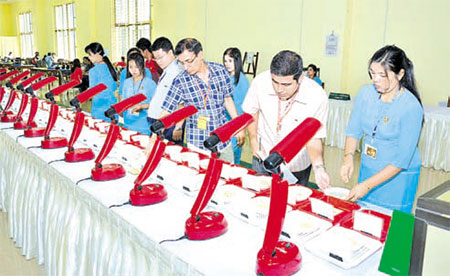 |
| Buyers examine lots at last month’s gem emporium. |
The finger was pointed at Chinese traders who would bid high for jade and then fail to collect. The material then is sold at a cheaper price to the Chinese in Yangon’s Shwe Li market as a “last stage” effort.
MT reported yesterday that Burma’s Ministry of Commerce was determined to do more to halt cross-border on smuggling, including jade, one of the most common illegal exports.
An instance of small-scale thwarting occurred in the Man Myo Market in Mandalay’s Maha Aung Myay township last month, according to another MT story. A jeweler there became suspicious when in the door came about 750 antique objects —silver and gold cups, ornaments, small rings; a “square-shaped gold locket with an embossed floral design”; “16 colourful jewels”; and five jade statuettes. The police were called on Ko Than Zaw, who it was confirmed had run across the items—literally—while plowing his field in Tha Man Taw village the first week of June. The precious metals alone were valued at $10,000. Ko was put in touch with archaeological experts. His field sits on the site of an ancient city that was destroyed, with the inhabitants burying their valuables as they fled the conflict. An archaeologist dates the objects to the 3rd to 5th centuries C.E.
One project that could impact illicit border trade is a proposed Special Economic Zone in Muse, Shan State, as reported by Mizzima. While the area has seen rebel activity, it is a commercial hub as well as being a conduit for black-market gems. [back to top]
With Pala Presents, we offer selections from the library of Pala International’s Bill Larson, who will share with us some of the wealth of information in the realm of gems and gemology.
This month we feature two pieces on birthstones. The first was authored by Sardha Ratnavira, father of artist and Pala neighbor Gamini Ratnavira, whose work has appeared in our pages (and whose mention appears above). Sardha, a native of Sri Lanka, was the first Asian to qualify at the Gemological Institute of America, in 1937–1938, when it was still in Los Angeles.
In “Know Your Gems” Sardha first looks at the relationship between gemstones and zodiacal signs. He then relates the stones to months—and to the Christian apostles, rounding out his piece with the significance of gemstones in dreams. This summer, we’d like to be dreaming of agate and amber.
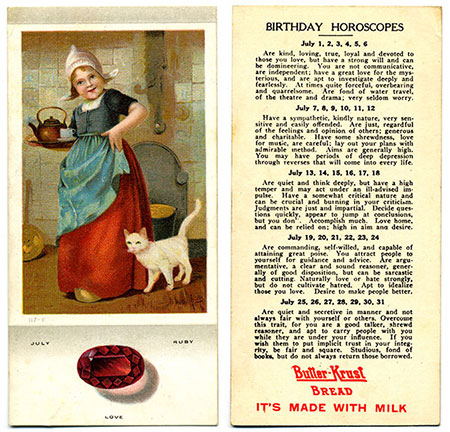 |
Our second look at birthstones comes by way of a set of collector cards issued in loaves of Butter-Krust Bread, as shown above, the verso of each containing five horoscopes. These likely are from the early 20th century. Their cousins—baseball cards also from Butter-Krust—are highly collectible, and can fetch thousands of dollars apiece. [back to top]
— End July Newsletter • Published 7/16/13 —
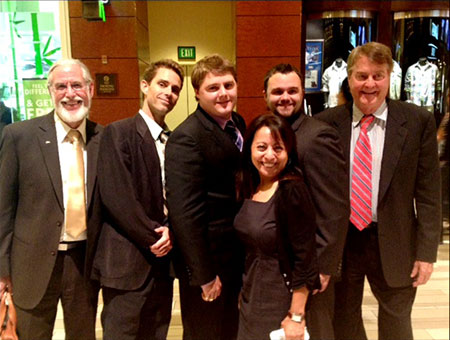 |
| The Bling Ring: The Pala crew at the AGTA GemFair in Las Vegas earlier this month. From left, Josh Hall, Jason Stephenson, Carl Larson, Gabrièlle Mattice, Will Larson, and Bill Larson. (Photo: Geri Vigil) |
As we noted last year, the Sainte-Marie-aux-Mines show has been through some changes since its inauguration in 1962. Then it was a small, local affair—a “day of mines.” Two years later the fair was entitled “Cailloux” (stones) and it attracted a regional audience. By 1966 it had become an “International fair of Minerals, Gems and Fossils.” While it originally was attended only by professionals—and professionals still enjoy their trade-only days—two days are now open to the general public. The show in 2012 attracted more than 25,000 visitors and more than 900 exhibitors.
Last year, the show received its new name, the International Exhibition Mineral & Gem at Sainte-Marie-aux-Mines. The exhibition celebrates its fiftieth year in 2013.
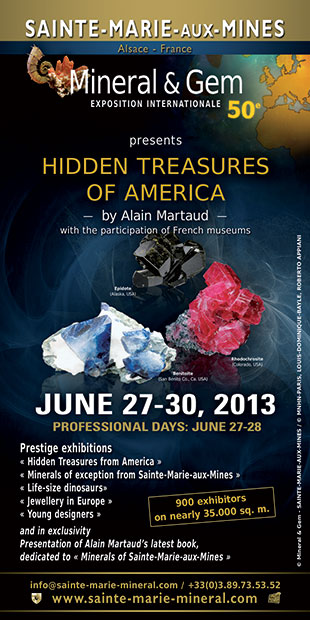 |
| This year, Pala pal Alain Martaud curates a special exhibition of American specimens. Alain is one of Pala’s French connections, having shared our room (and our wine) at Tucson’s Westward Look Hotel for years. (Click to enlarge image) |
To get a taste, see:
This year, Bill, Will, and Carl Larson will attend the show along with friend and fellow gem dealer Mark Kaufman. They will follow that with a business trip to the gemstone center of Idar-Oberstein in Germany.
What: Mineral & Gem à Sainte-Marie-aux-Mines
When: June 27–30, 2013
Where: Sainte-Marie-aux-Mines, France
We look forward to seeing you there.
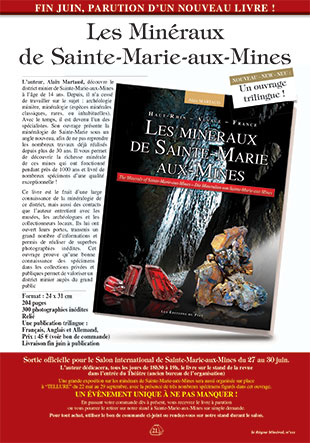 |
| Alain Martaud debuts his new book, The Minerals of Sainte-Marie-aux-Mines, at the show. It is a tri-lingual edition (French – English – German). Martaud will sign the book each day from 6:30 to 7:00 pm at the magazine stand in the theater entrance. (Click to enlarge image) |
[back to top]
Pala International heads to the East Coast later this summer for the trade-only JA New York Summer Show. Stop by to see one of America’s largest selections of fine colored gems.
 |
See this list of seminars to be held at the show.
When: July 28–July 30, 2013
Where: Jacob K. Javits Convention Center
Hours: AGTA Gemstone Section
Sunday, July 28: 10:00 AM – 6:00 PM
Monday, July 29: 10:00 AM – 6:00 PM
Tuesday, July 30: 10:00 AM – 4:00 PM
Pala International is in booth 2581. See the JANY website for more information. Visit the Pala International Show Schedule for future events. [back to top]
 |
The 3rd Annual Dallas Mineral Collecting Symposium is scheduled for August 23 and 24. The event kicks off with a Friday night cocktail party at the Perot Museum of Nature and Science.
The symposium itself takes place on Saturday at Southern Methodist University’s Cox School of Business. Pala International’s Bill Larson will speak on “40 Years at the Himalaya Mine.” The tentative list of speakers:
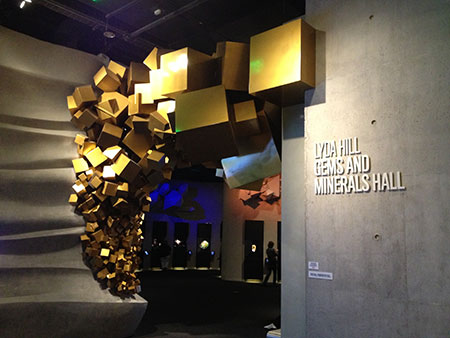 |
| Entrance to the Lyda Hill Gems and Minerals Hall, in the still-new Perot Museum of Nature and Science. (Photo: Bill Larson) |
[back to top]
Last month, the 15th ICA Congress was held in Changsha, Hunan, China. Some of the highlights are covered on the ICA website. You’ll want to see officials pouring wine into a Chinese dragon ice sculpture featuring the ICA logo.
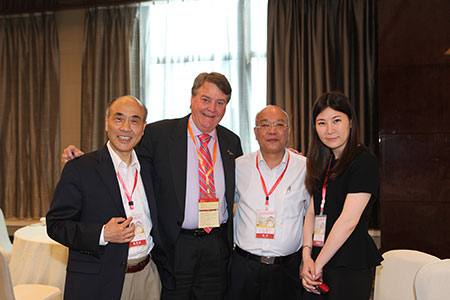 |
| From left, George Shen, Pala International’s Bill Larson, ICA President Wilson Yuen, and Livia Ni, vice manager of financial investment group Zhongrong Holdings. (Photo courtesy George Shen) |
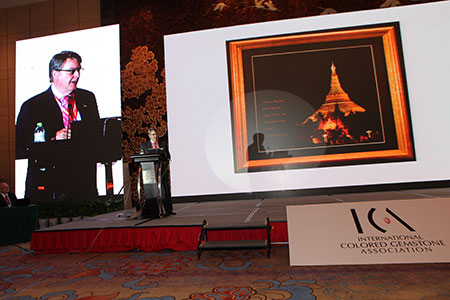 |
| Larger than life. Pala International’s Bill Larson delivers a presentation on Burma at this year’s ICA Congress. (Photo: George Shen) |
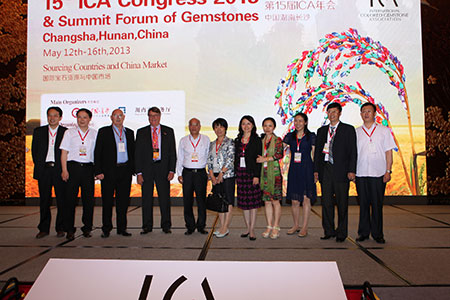 |
| ICA Congress presenters. Click to enlarge. (Photo: George Shen) |
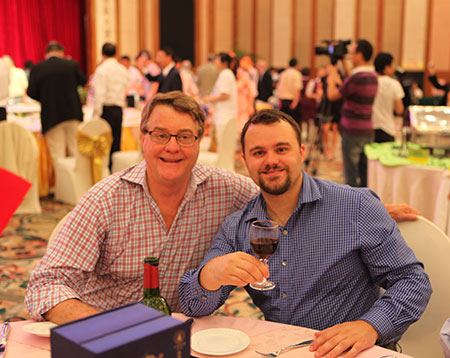 |
| À votre santé… Above, ICA Ambassador to the USA Bill Larson, left, and son Will Larson, at one of the dinners for ICA, which included VIPs for the China (Changsha) Mineral & Gem Show. As Bill told us, “We were as usual cross-pollinating, in both areas—gems and minerals.” (Photo: George Shen) |
[back to top]
A century ago, laborers in London’s financial district of Cheapside (a street name meaning “marketplace”) uncovered a huge collection of Elizabethan and early Stuart jewelry—nearly 500 pieces. The stash, now known as the Cheapside Hoard, had been squirreled away beneath a cellar floor. It is assumed that the collection had been hidden prior to the Great Fire of London, in 1666, due to evidence of the fire in recent excavations at the site. But the burial date was unknown until more recently.
 |
| St Mary-le-Bow. Cheapside in 1909, above, three years before the collection that bears its name was uncovered. In the background stands St Mary-le-Bow, which stands on the site of a church that was wiped out by a tornado in 1091, and another that was destroyed in the Great Fire of London in 1666. The latter church’s stone arches, or “bows” gave the church its name. |
Key to the dating was an overlooked bright-tangerine carnelian intaglio bearing the heraldic badge of William Howard (1612–1680). Howard was the first (and only) Viscount Stafford, and received his peerage in 1640. Thus the intaglio was carved between 1640 and 1666. It, and every other item from the original find, will be displayed beginning October 11, 2013 through April 27, 2014 at the Museum of London. Tickets go on sale this month.
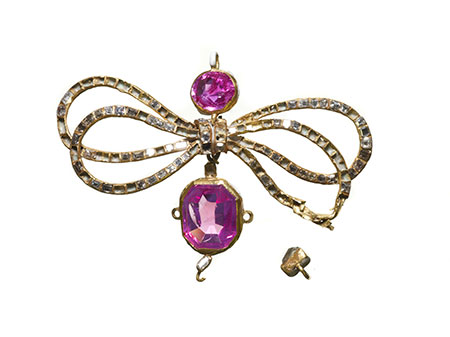 |
| Le bow. Gold bow pendant (dated 1501 to 1625) set with rose-cut and step-cut foil-backed rubies and table-cut diamonds. The pendant, called a “flower” in Elizabethan times, was often attached by a ribbon to the left breast. Pendants also adorned the hair and the neckline. (Images © Museum of London) |
The exhibition’s curator, Hazel Forsyth, was quoted in a press release as saying that the Stafford intaglio “mak[es] a specific link to an individual who had international connections and a penchant for collecting gems and antiquities.” Curator Jackie Kelly told Reuters that some other items in the collection might have belonged to Stafford, then were sold during the English Civil War (1642–1651), as likely were many of the other pieces. Kelly speculated that the owner of the hoard was a jeweler or goldsmith who went off to fight, never to return.
The exhibition will include rarely viewed portraits, multimedia installations and historical objects from the museum’s collection.
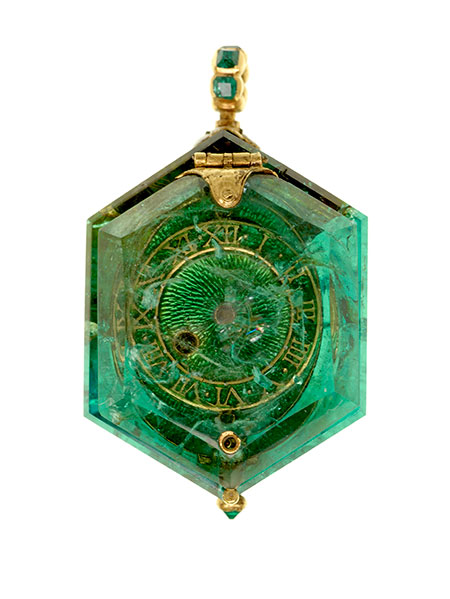 |
| Time stands still. Watch (dated 1576 to 1600), set in single large Colombian emerald crystal of hexagonal form with hinged lid. The movement and dial plate are corroded and cannot be raised out of the setting. The dial plate is enameled in translucent green and the circular gold suspension loop and button securing the movement at the base are set with small emeralds. The suspension loop is set in a white enameled flower, c.1610. The main body of the case is cut from a single piece of emerald with a lid of faceted emerald. The catch for the lid consists of a gold pin set in the base which passes through a hole in a gold tube set in the lid. The watch has a gold dial overlaid with dark green enamel through which can be seen the engraved design of radiating lines. (Images © Museum of London) |
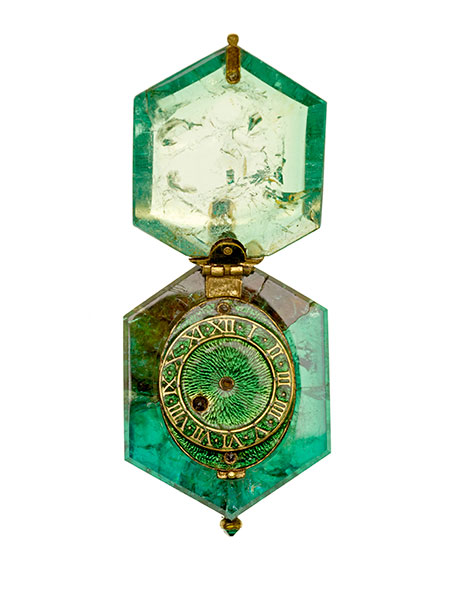 |
For a discussion of some of the interesting enamel work—two examples of which we feature here, in the watch above and pendant below—see this reprint of a Glass On Metal article from 2004. It includes a review of a now-out-of-print book on the collection by curator Hazel Forsyth. For more on the hoard see this article by author JoAnn Spears from the website On the Tudor Trail.
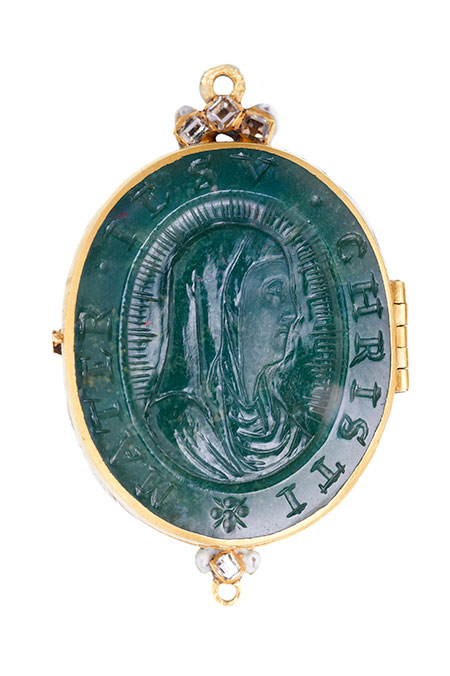 |
| Requiescat in pectorum. This reliquary pendant (dated 1501 to 1625) incorporates bloodstone cameos of the head of Christ, with a text from the Gospel of John, “I am the Way the Truth and the Life,” and a profile bust of the Virgin Mary, with the legend “Mother of Jesus Christ.” The inner hoop is enameled with the Instruments of the Passion, i.e., spear (actually a lance), ladder, spike, a scourge perhaps, etc. (Click to enlarge) The cutter chose the stones with care to underline the theological message of the jewel, selecting the most visibly flecked bloodstone for the head of Christ. This cameo has stylistic similarities to medals of Christ attributed to Antonio Abondio (1538-1591) and to other bloodstone cameos produced in Prague for Rudolf II. (Images © Museum of London) |
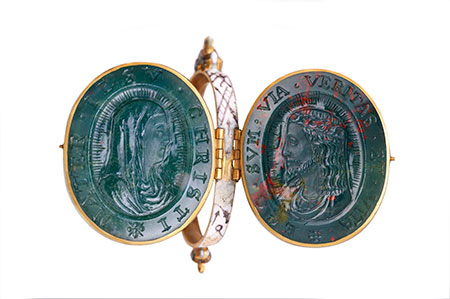 |
Later this summer, the museum’s Cheapside Hoard wall calendar will be available via Amazon.com. [back to top]
This month we feature an epic star sapphire from Burma. This massive chunk of corundum has found its way to Pala after being oriented and cut down to a shallow cabochon, leaving a large face-up appearance. It is polished to reveal a sharp and well formed star with an intense blue body color we associate with fine Burmese sapphires. This rare and unique combination of a fine star and pure blue color is a treat for the eye and and fun for the imagination. All the dynamic optics and chemistry are coming together in one stone to produce a fine world class specimen.
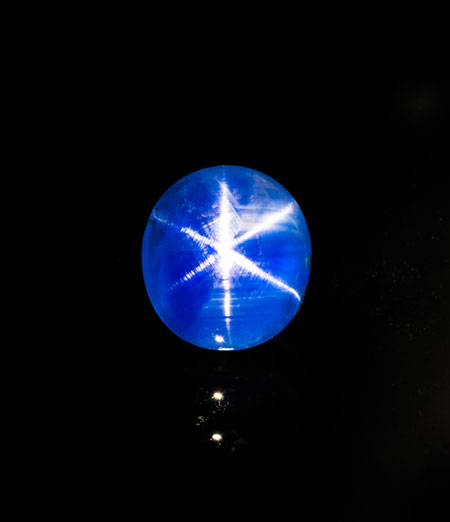 |
| Fine Burma blue star sapphire, 29.51 carats, 18.15 x 16.62 x 8.71 mm, Inventory #21218. (Photo: Mia Dixon) |
Interested? Select the inventory number above, call (phone numbers below) or email us to inquire. [back to top]
In late 2010, we pointed to a two-part overview of an expedition by Dr. George Harlow and colleagues to research the origins of jade in Guatemala. Last week, Dr. Harlow was quoted in the New York Times regarding the same research, following recent articles in Geology and Earth and Planetary Science Letters, coauthored by Harlow. In the Times, geologists are likened to geological chefs, sampling the earth’s creations, attempting to re-create the recipe. These scientists have concluded that jade has oceanic origins, whereas rubies, for instance, formed in mountains, even if those mountains have long been eroded. (Brings to mind a ’67 ditty by Brit popster Donovan Leitch.)
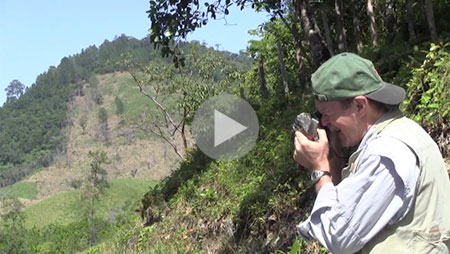 |
| Dr. George Harlow examines a specimen in a still from “Solving a Geological Puzzle in Guatemala." |
[back to top]
Richard Hughes has published a study of glass-infilling in blue sapphire along with colleagues Thanong Leelawatanasuk, Wilawan Atitchat, Visut Pisutha-Arnond, Pornsawat Wattanakul, Papawarin Ounorn and Wimon Manorotkul. It was published in Australian Gemmologist but is available at Hughes’s website.
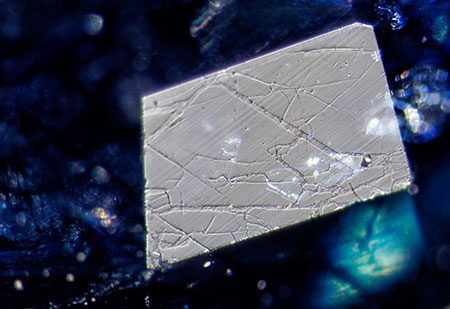 |
| Nazca lines? No; it’s a single facet displaying a network of glass-filled fissures. (Photomicrograph: Wimon Manorotkul) |
The latest infilling technique was developed by Tanusorn Lethaisong (see our coverage of this from early 2008). Hughes et al. explain how to use fairly simple observation techniques to detect treatments.
If the preceding study whetted your appetite for the microworld, check out GGTL’s collections of micrographs: diamonds, rubies, sapphires, emeralds, pearls and others.
The Swiss Gemological Institute has posted several colored gemstone presentations. One, from March, is a “Western” look at Fei Cui (pyroxenitic jade) and other jades and jadeites. Also an overview of corundum treatments.
JCK reported on June 5 about a dealer sending a single diamond to four leading labs. Three graded the color the same; the fourth’s was within a single grade, so not bad. But JCK reported on June 10 about a Rapaport survey that sent ten diamonds to domestic and foreign labs. The results differed by as many as three color grades. [back to top]
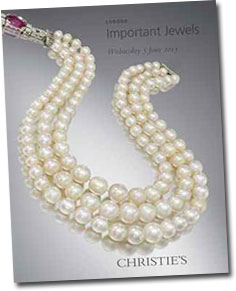 |
| The pearl necklace was cover star for the sale’s catalog. Learn more about pearls at free upcoming GIA events in Bangkok and Singapore. |
On June 5, Christie’s sold a beautiful three-row, natural saltwater pearl necklace. Crafted in about 1925 (the sale was of Art Deco jewels), the necklace fetched nearly twice its upper estimate of £530,000, realizing over $1.6 million.
This necklace clasp features a lovely oval, mixed-cut ruby set in a geometric surround. The clasp, which appears to consist of five hinged segments, also is set with baguette and circular cut diamonds. (See zoom-able image here.)
As was noted in the pre-sale news release, pearls were a de rigueur element of the 1920s jewelry box; nearly 100 years later, the market is strong for pearls once more.
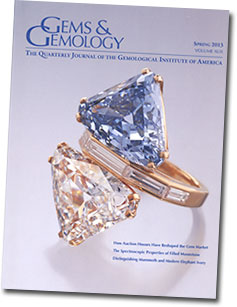 |
The latest issue of Gems & Gemology, Summer 2013 Volume XLIX, highlights auctions in an article by Russell Shor, “Auction Houses: A Powerful Market Influence on Major Diamonds and Colored Gemstones.”
Shor has compiled a neat little list of the top selling prices for diamonds, fancy colored diamonds, sapphires, rubies, and emeralds. He draws on statistics from the world’s two biggest auction houses, Sotheby’s and Christie’s.
Record prices keep appreciating as gems draw a more worldwide and wealthy market. As the global population grows, wealth seems to grow right along with it. Money seems to be in an inflationary period as values of gems keep doubling on us in the trade, and auctions seem to keep breaking records that seemed unimaginable as of the previous auction. Money is moving and the ones who have it seem to be spending it on the finest, rarest things on the planet—and it always helps if there’s a celebrity attached to the story. Provenance also equals big bucks in the auction trade. Famous figures, famous designers, and fine rare gems seem to be the recipe that is cooking up a fireworks show of millions and millions of dollars being spent on these precious jewels from this growing global market.
Some highlights from the list of top-sellers:
[back to top]
On May 17, $1 million worth of jewels were stolen at the Cannes Film Festival from a safe in the hotel room of a Chopard employee. (The safe supposedly was cut out of the room, in toto. Days later, a $2.6 million necklace was stolen during the 20th anniversary party of Swiss jeweler de Grisogono. Interestingly Chopard’s Caroline Scheufle once was married to de Grisogono’s Fawaz Gruosi.
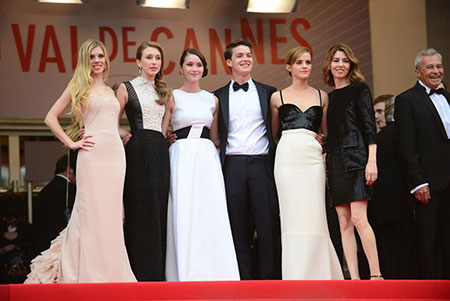 |
| Blingsters. Sofia Coppola, right, stands with the cast of The Bling Ring, which premiered at the festival. Coppola’s film is based on a real-life teenage crew who used social networking to keep tabs on celebs—and rob them. Emma Watson told The Hollywood Reporter she had nothing to do with the Chopard heist. |
Journalist/blogger Roger Friedman speculated that the second heist was a publicity stunt, saying that de Grisogono “jumped on the burglary bandwagon.” Maybe. When he asked Scheufle for follow-up on the theft, she said it was no big deal, since the firm has ample insurance and implied that the publicity is worth a fortune. Friedman points out that Chopard was shunted aside as Tiffany & Co. sponsored the festival’s opening night, a first.
Last month we noted the arrest of thirty-one people suspected in having a hand in a meticulously planned and executed robbery of $50 million worth of diamonds in Brussells in February. The New York Times reported on Saturday that the post-robbery attempts to unload the loot were as laughably amateur as the robbery was skillful. Rather than waiting, say, for a trade show, efforts were made to sell the diamonds in Geneva, which, as was pointed out by Edahn Golan, a diamond industry analyst, is not a big diamond center. [back to top]
 |
| Spinel bourguignon. Nice oval Burgundy spinel from Burma, 3.95 carats. Inv. #18089, from our Old Stock… New Pix section. (Photo: Mia Dixon) |
Burma’s government-run newspaper, The New Light of Myanmar, didn’t always play up the semiannual gem emporiums held in the spring and fall. Last fall’s sale didn’t take place at all, due to armed conflict in Kachin that suspended jade mining. But this spring’s Annual Myanma Gems Emporium is the fiftieth, and so the newspaper is covering it, with several articles published over the last few days.
Registered to attend the sale were 3,926 foreign merchants and 4,747 local merchants, according to the newspaper’s June 15 edition. Scheduled to be sold through open tender were 9,657 jade lots, 273 gem lots and 234 pearl lots. Bidding was to apply to 346 jade lots, 106 gem lots and 21 pearl lots. The sale takes place in Mani Yadana Jade Hall and the Myanmar Gems Museum in Nay Pyi Taw, June 15–27.
At the opening ceremony on Saturday, gifts were bestowed: government minister Dr. Myint Aung was given a jade statue of Bodaw (a nat or spirit worshiped by Burma Buddhists), a ruby crystal weighing 1,907 carats and more, according to the newspaper’s June 16 edition.
Since 1964, 86 sales have been held. The newspaper mentioned one jade lot, from the Warkyal mine in Lonkhin-Phakant is offered at €15 million. New at this sale is a media entry fee, according to Xinhua: 60,000 kyat for locals and $100 for foreign correspondents.
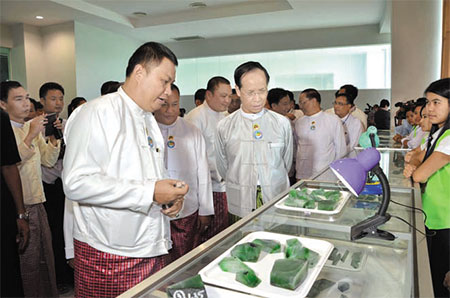 |
| Burma Vice President Dr. Sai Mauk Kham looks at jade lots as part of the opening ceremony of the emporium on Saturday. |
Taung Kyi, the secretary of the Gem Traders Association (Myitkyina) told Mizzima News that his organization is pulling for its own legal jade market in Myitkyina, the capital of Kachin. Such a market would allow jade slabs to be transported only 60 miles from mines in Hpakhant. Taung told Mizzima that most of the jade from the region ends up in China, illegally. Presumably a local market could change that.
In other Burma news…
[back to top]
With Pala Presents, we offer selections from the library of Pala International’s Bill Larson, who will share with us some of the wealth of information in the realm of gems and gemology.
In 1915, the Pala Chief Gem Mining Company installed a life-size replica of Pala Chief mine at the Panama–California Exposition, which was held in conjunction with the opening of the Panama Canal. San Diego, by virtue of its location, was the first port of call for ships sailing north from the canal, and the local Chamber of Commerce hatched the idea of an exposition to show off the city of 40,000. (A similar world’s fair also was held that year in San Francisco.) The signature Spanish-Baroque Revival architecture of San Diego’s Balboa Park is the impressive byproduct of the 1915 exposition as well as the California–Pacific International Exposition of 1935.
At about the time of the 1915 exhibition, the Pala Chief Mining Company published a booklet, Tourmalines – California’s Most Beautiful Gem, our Pala Presents offering for June, which explained about the mine exhibit.
In this wonderful exhibit is shown the method of mining the tourmalines, and many remarkable specimens of the beautiful gems in the rough. Visitors pass through tunnels like those dug by the miners in the mountainside, and see embedded in the natural rock brought from the mine the huge crystals, or Spodumene, just as they are found in Nature.
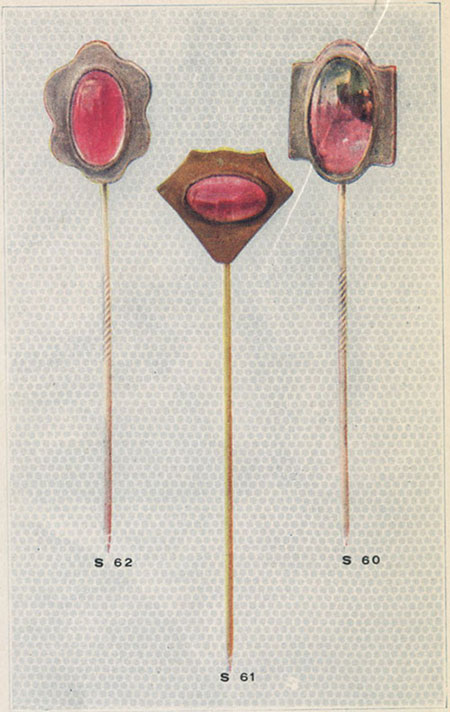 |
| A request of our readers: Have you seen any of the copper or sterling objects contained in the booklet catalog? If so, we want to hear from you. |
The booklet includes an overview of tourmaline from San Diego County and then settled down to the business of business, reprinting a check from Tiffany & Co. to mine owner Frank A. Salmons as well as a letter from the jeweler complaining about the price it had to pay—$150—for three tourmaline crystals. Rounding things out, the booklet displays a small catalog of tourmaline pendants, brooches, rings, bracelets, scarf pins (shown above), watch fobs, and desk items. The hundred-year-old prices are sure to amuse… [back to top]
— End June Newsletter • Published 6/17/13 —
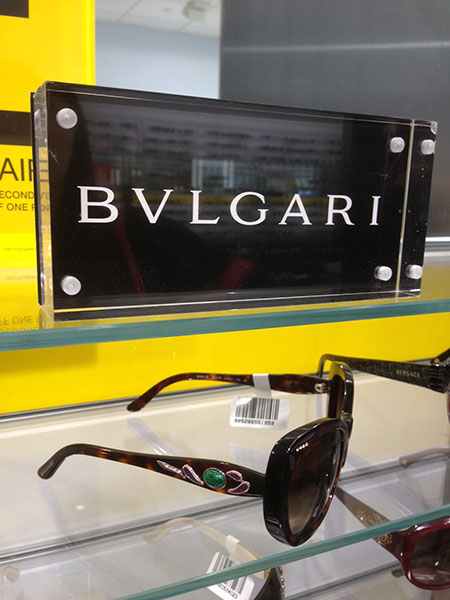 |
| Not your mother’s tortoise shell… Bulgari gets all fancy with paisley and half-round cabochon in its sunglasses design. For some vintage Bulgari, see this. (Photo: Will Larson) |
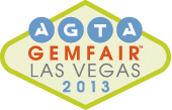 |
It’s time to plan for the JCK Las Vegas show. Pala International will be there in force, with one of America’s largest selections of fine colored gems.
Note: The JCK Show this year will run Friday through Monday.
When: May 30 – June 3, 2013
Where: South Pacific and Islander Ballrooms in the Mandalay Bay Convention Center, Las Vegas, NV
Hours: AGTA Gemstone Section
Thursday, May 30 thru Sunday, June 2:
9:30 AM – 6:00 PM
Monday, June 3: 9:30 AM – 4:00 PM
Booth: AGTA Pavilion, booth AGTA514
The AGTA Gemstones and Pearls education track is posted here along with a list of GIA seminars.
We look forward to seeing our many friends there. Visit the Pala International Show Schedule for future events.
 |
| What’s hAppening? Pick up the free JCK 2013 Mobile app. If you like the way the JCK website lets you add to your JCK Show Planner, you’ll want to put that on your smart phone. You’ll also have access to details about all the exhibitors, selected items like specials and products, transportation options, and dining choices (names listed by venue but no links). And you can remind yourself of when Shane McClure is doing his Ruby Treatment Identification presentation as well as when Maroon 5 Rocks the Beach. |
[back to top]
They found me dangling where his golden wind
Inflicted so much music on the lyre
That no one could have told you what he sang.
While they are separated by centuries (eventually overlapping), two exhibitions at the Bowers Museum highlight the bejeweled beauty produced (and collected) first under the patronage of the Medici in Florence and later by the Romanovs of Moscow.
Currently displayed until September 15, Gems of the Medici actually predates the family (14th c.–1737), as it includes antiquities such as the sardonyx carving pictured below. The exhibition consists of 100 objects from several prestigious Florentine museums including the Museo degli Argenti, Palazzo Pitti, and the Museo Archeologico Nazionale Firenze.
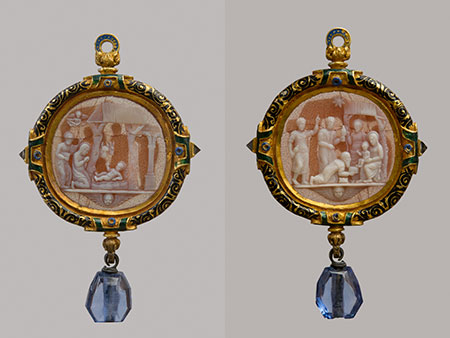 |
| Venite adoremus. Onyx cameo, enameled gold mount with diamonds and sapphire, undated, unknown Florentine workshop, Firenze, Museo degli Argenti. Left, Nativity (obverse); right, Adoration of the Magi (reverse). (Photo courtesy Bowers Museum). |
For three hundred years the Medici commissioned and collected in Florence. As noted in a Bowers press release, the family not only dominated the local political landscape there but also “steered the course of art history,” becoming a magnet for talent. Art patronage began with Giovanni di Bicci de’ Medici (1360–1429), who built the first international banking system. His son, Cosimo (“the Elder”) de’ Medici (1389–1464), began the family’s gem collection. His son, Piero il Gottoso (“The Gouty”) also had an eye for engraved gemstones, displaying them in the study of the first Renaissance palace built by his father.
Cosimo the Elder’s grandson, Lorenzo (“The Magnificent”) de’ Medici, had in his court the artists that any schoolchild knows today (as long as they remain ignorant of the artists’ private lives): Botticelli, Michelangelo and Leonardo. The first section of Gems of the Medici is devoted entirely to Lorenzo’s gemstone collection. It includes the beautifully staged Seal of Nero, a carnelian that depicts Apollo at the moment of his victory over the satyr Marsyas, who had challenged the god to a contest of music. As writer Mary Jo Gibson points out, behind the bound Marsyas, who sits on a lion’s skin, stands a tree from which hangs the sheath of the satyr’s reed instrument. Both these details prefigure Marsyas fate: the rules of the challenge allowed the victor to dispense with the defeated as he wished, and thus the satyr was flayed, with his skin nailed to a tree by Apollo. (It seems that antiquity provides inspiration for today’s independent filmmakers…)
Lorenzo’s collection remained with the Medici until a descendant’s widow, Margherita of Austria (1522–1586), included it in her dowry when marrying Ottavio Farnese, Duke of Parma, grandson of Pope Paul III. She was 15, he 14, and it is said that, willful thing that she was, she actually had her eye set on Cosimo—that is, Cosimo I de’ Medici. (Visitors to the Getty in Los Angeles can see what attracted Margherita: the gorgeous portrait of what is proposed to be Cosimo as a teenager, painted by Mannerist pioneer Jacopo Pontormo. While at the Getty, view the imposing portrait of Giulio de’ Medici, 1478–1534, who reigned as Pope Clement VII; it is executed on immortal slate, by Sebastiano del Piombo.)
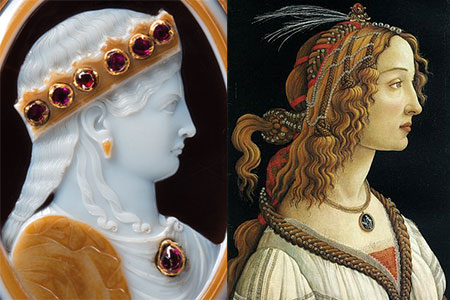 |
| Sitting pretty. Left, bust of a princess or empress, represented as Juno, ca. 10–40 C.E., composed of sardonyx, gold and rubies, 49 x 36 cm, Firenze, Museo Archeologico Nazionale (courtesy Bowers Museum; click to enlarge). Right, a young woman of Frankfurt, thought to be Simonetta Vespucci, whose husband was a distant cousin of our nation’s namesake, Amerigo. The couple were fêted by the Medici, and Simonetta is thought to be the subject of many a famous painting, as above, by Sandro Botticelli. In this portrait (1480–1485) she wears Nero’s Seal, the carnelian of which is included in the Bowers exhibition. |
With Lorenzo’s collection removed (it forms the core of the Museo Archeologico Nazionale di Napoli), Cosimo (1519–1574), Grand Duke of Tuscany, set about the formation of a new collection. Contemporary documentation shows that he—and his wife Eleonora di Toledo (1522–1562), who purchased the Palazzo Pitti, from which many Gems of the Medici objects hail—spared no expense in obtaining gems of great value, old and new. They were guided by artist Benvenuto Cellini, who “restored” a Hellenistic chalcedony cameo fragment in gold (an image of which graces a Bowers press release). These gems form the second section of the exhibition, and provide the seed for what is known as the grand ducal collection. Medici heirs would build on that collection, displayed in section 3: Baroque Splendours.
Section 4: Twilight of a Dynasty exhibits the acquisitions of Gian Gastone (1671–1737), the last Grand Duke of the Medici dynasty. While his accessions were not as ambitious as those of his forbears, he did acquire, for instance, a 300-piece collection of Abbot Pietro Andrea Andreini. It includes carvings by many famous engravers of antiquity. It is during this time that word of the collection spread in Europe. Grand Tour travelers might spend months in Florence, and the Medici collection was on the short list of sights. (A fifth section of the exhibition covers a typical 16th century workshop, the Galleria dei Lavori, to illustrate how the gems were crafted.)
Anna Maria Luisa de’ Medici (1667–1743), the last of the Medici, and sister of Gian Gastone, took possession of the collection at his death. She imposed that the collection remain intact, but following her death many of the gems were divested of their gold frames and jewels. Those that remain in their original mountings come before the U.S. public for the first time, in Gems of the Medici. Events in conjunction with the exhibition are listed here.
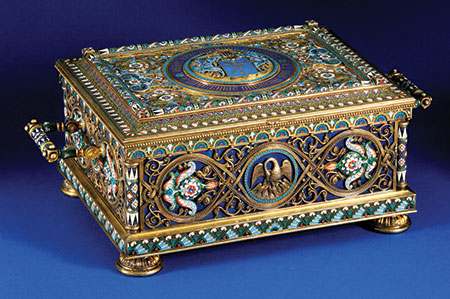 |
| Case and casket. Above, Durnovo casket, Firm of Ovchinnikov, Russia, 1889, silver gilt, enamel and lapis lazuli. Below, cigarette case, Fabergé, Russia, c. 1900, palisander (rosewood), two-colored gold, diamonds and pearls. (Photos: © Giovanni Lundardi Photography, courtesy Bowers Museum) |
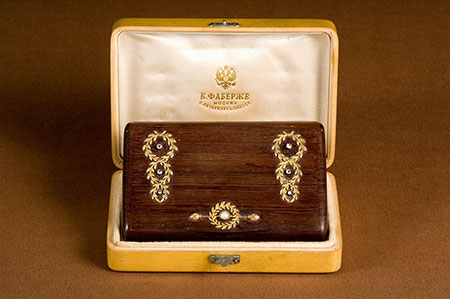 |
If not as impressive to the gemstone aficionado, aesthetes in general will want to take in The Tsars’ Cabinet: Two Hundred Years of Decorative Arts Under the Romanovs, which is up from June 8 through September 1 of this year. The exhibition covers the time of Peter the Great (1672–1725) to that of Nicholas II (1868–1918).
The Bowers press release states that
The objects exhibited provide a rare, intimate glimpse into the everyday lives of the tsars. The collection brings together a political and social timeline tied to an understanding of Russian culture. In viewing The Tsars’ Cabinet, one is transported to a majestic era of progressive politics and dynamic social change.
While imperial factories churning out yacht-service sherbet cups, and snuffboxes bearing Catherine the Great’s portrait, may not conjure up notions of liberality, there is truth to the Bowers statement. As Simon Karlinsky has written (Hidden from History, New York: New American Library, 1989, pp. 347–364), “When the topic of repression and liberation in Russia is brought up, many people in the West tend to visualize it in simplistic and schematic terms. First, they believe that Tsarist Russia was an inflexible tyranny that had never changed since the time of Ivan the Terrible.” For instance, Alexander II, as Karlinsky notes, initiated “the abolition of serfdom, the replacement of a corrupt judiciary system with [open] trials by jury…, reduction of military draft from twenty-five years to five, and other liberal reforms.” Russia was not a democracy, but these reforms “did free fifty-two million enslaved human beings, allow some autonomy in local self-government and relax the censorship of books and periodicals,” Karlinsky writes.
If there was social evolution—and in 1905, revolution—in Russia, The Tsars’s Cabinet shows evidence of stylistic change, as addressed in the press release.
Porcelain, glass, enamel, silver gilt and other alluring materials make this extensive exhibition dazzle. The items demonstrate the evolution of style from the European Classicism of the court of Catherine the Great, to the rich oriental motifs of mid-nineteenth century Russian Historicism of the Kremlin and Grand Duke Constantine Nicholaevich services and the enamel work of Fedor Ruckert and the firm of Ovchinnikov.
Individual items that our readers will want to look for (out of a total of 234):
[back to top]
Visitors to Fallbrook, California’s 27th Annual Avocado Festival in April received an added treat, as the Fallbrook Gem & Mineral Museum unveiled a new exhibit: the Betty Robson Egg Collection. The collection, originally bequeathed to Betty by her husband, John Robson, contains 177 egg-shaped objects. According to an April 18 article in the local Village News, the collection includes fossilized material as well as “rocks and minerals.” Two of John’s favorites are on display: an amber egg containing a 50 million year old ant, and a boulder opal from Queensland, the most valuable of the collection (both are pictured in the article).
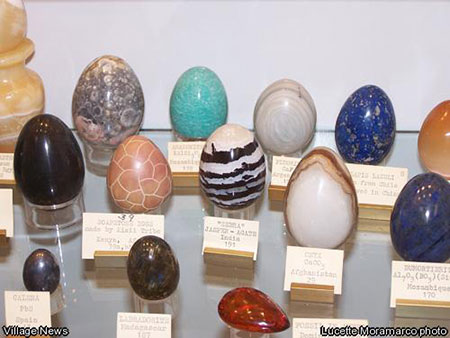 |
| Thousand-year-old eggs. A few of the 177 items in the collection, which also includes objets d’art. (Photo: Lucette Moramarco, Village News) |
By the time of John’s death in 2010, his collection numbered nearly 300. Betty kept 30 for herself, including an egg containing borax, which speaks to her 30 years at U.S. Borax R&D in Anaheim. With the donation of this collection, the museum has started a new exhibit area that will rotate displays four times a year. [back to top]
This month we feature a gargantuan spessartite garnet from Nigeria. Weighing in at 58.44 carats, this oversized jewel came to us through an estate collection recently. It probably was obtained between 1999 and 2007, when the Nigerian deposit was in full swing. The mining area in western Nigeria, Oyo State, produced by far the largest quantity of spessartites the world has seen. This massive deposit was known for quality as well, recovering many 10-carat-plus, near flawless mandarin colors, and a plethora of fine smaller sizes. Colors ranged from burnt reddish orange to the pure orange hues.
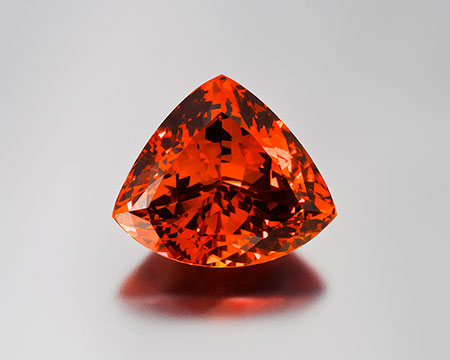 |
| Nigerian spessartite, 58.44 ct, 28.00 x 22.43 x 13.82 mm, Inventory #20641. (Photo: Mia Dixon) |
Pala International bought into one of the large parcels of rough back in 2004, and we are still supplying fine pieces in the 1 to 6-carat range. But since this epic find, which only lasted a few years, the mines have been exhausted and nothing has compared, causing the prices for fine orange spessartite to see a steady rise over the years. Our featured stone really shows the beauty of the material: deep orange hue and a unique modified trillion cut. Perfect for a museum or collector of the oversized gems.
Interested? Select the inventory number above, call (phone numbers below) or email us to inquire.
For those of you who didn’t “cheat” by clicking on last month’s inventory items: the ruby is on the left. [back to top]
 |
DIYers may have noticed some Pala placement in the March edition of Martha Stewart Living. In “American Gems,” crafts editor Hannah Milman shows readers how to fashion their own jewelry items from homegrown sources. “From the emerald-rich hills of North Carolina to the sapphire-laden mountains of Montana”—and, of course, from the tourmaline mines of Southern California. Also included from California are benitoite and garnet.
The pink tourmaline beads from Pala International, pictured below, are featured in the eight-page spread, which tells readers which states produce various stones as well as providing examples of easy-to-craft jewelry items. In the magazine’s Workbook section, three more pages show how to create a pearl necklace, hoop earrings (featuring Pala tourmaline beads), a linked bead necklace and a leather necklace.
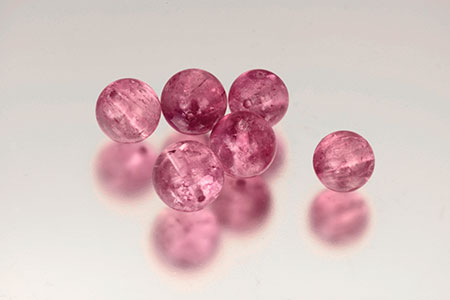 |
| Busy beads. These pink tourmaline beads from Pala International, with a total carat weight of 31.66 carats, were featured in the March edition of Martha Stewart Living. The magazine used the beads in examples of craftable hoop earrings and a linked bead necklace. (Photo: Mia Dixon) |
[back to top]
Italian actress Gina Lollobrigida’s jewelry collection was the highlight at the Sotheby’s auction in Geneva on May 14, when her Bulgari natural pearl and diamond earrings sold for a record-setting $2.3 million. The sale of Gina’s earrings, from 1964, topple a previous record set by the queen of jewels herself, Elizabeth Taylor. Taylor’s Bulgari natural pearl and diamond earrings sold for $1.98 million back in 2011. Lollobrigida’s entire collection was sold for a combined total of $4.96 million. Other highlights of her collection included a diamond and necklace set by Bulgari from 1954, and a 74.53-carat cushion-cut fancy yellow diamond. Lollobrigida’s emerald collection from Bulgari brought in some strong numbers as well; earrings went for $247,000, a ring brought in $180,000, and a 27.57-carat emerald brooch fetched just over a million dollars.
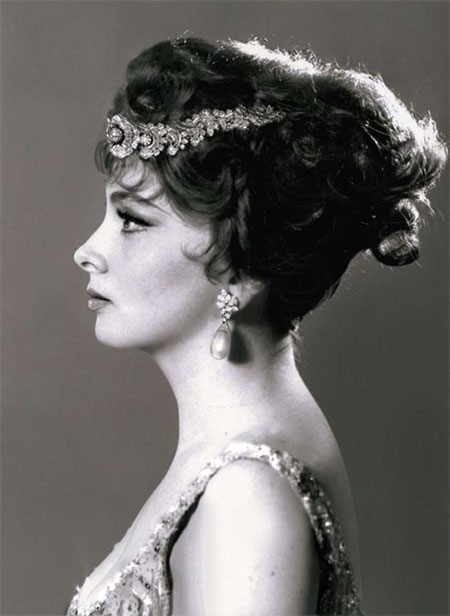 |
| Her best side. Gina Lollobrigida wearing the diamond necklace/bracelet combination, Bulgari, 1954 as a tiara (lot 663) and the record-breaking natural pearl and diamond pendant earrings (lot 664). (Photo: Sotheby’s press release) |
Lollobrigida says, “I love the stones—the pearls and emeralds—because they are natural, the raw products of nature.” Now 85, Lollobrigida, stays busy as a photojournalist and sculptor working out of her studio near Carrara, Italy.
Other notable sales in the Magnificent Jewels section included a 27.9-carat D-color internally flawless cushion-shape diamond which sold for $4.45 million, a 31.35-carat cushion-cut diamond that fetched 1.83 million, a 11.71-carat Kashmir sapphire, and a 43.27-carat sapphire in a diamond brooch. View the sale overview here.
Late last month, Bonhams took the world record of £6.2 million (about $9.3 million) for a rare fancy deep-blue diamond weighing 5.30 carats, or $1.8 million per carat. The previous record was $1.68 million per carat. The diamond was set in a Bulgari mount, ca. 1965, pavé set with brilliant-cut diamonds and courses of baguette-cut diamonds.
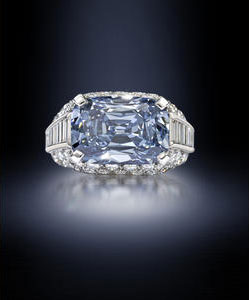 |
| Over the past ten years, fewer than 30 blue diamonds of 5+ carats have appeared at auction. This one was acquired by Graff. (Photo: Bonhams press release) |
[back to top]
As the above Sotheby’s sale demonstrates, an investment today can lead to a nice return tomorrow. Both items pictured above went for well above their pre-sale estimates. In last week’s Wall Street Journal article, “Collectors Focus on Jewels as Investments,” art market reporter Kelly Crow notes that Sotheby’s sold a 24.78-carat pink diamond (the “Graff Pink”) in 2010 for nearly $46 million—“more than anyone has ever paid for a canvas by Camille Pissarro or Paul Gauguin.” (All this might be lost in the hubbub surrounding this week’s Sotheby’s sales of Newman, Richter, Klein, Still et al. for tens of millions…)
Crow points out what the savvy have known for some time: jewels are portable and relatively liquid. She quotes Martin Rapaport as saying that a billionaire friend bought a hundred 1-carat diamonds, having them fashioned into “a Roaring Twenties-style strand.” Should markets tumble, his wife could fly stylishly, with a fortune around her neck, to offload at the destination.
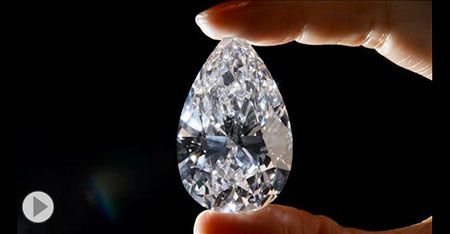 |
| Reporter Kelly Crow discusses “A Man’s Best Getaway Asset” on Lunch Break. |
The article moves around the world to see what investors are collecting and even how the auction houses have changed their marketing approach from the days of black-and-white catalogs with prim, crisp—and uninformative—descriptions.
Thirty-one people suspected of doing their own illicit investing in $50 million worth of diamonds were arrested last week in Belgium, France and Switzerland. On February 18, thieves dressed as police, with blue lights flashing, approached a plane carrying the diamonds from Antwerp. They boarded the plane and took the loot in a well-oiled operation that took about five minutes.
Bloomberg reported on May 1 that middle-class Chinese are buying diamonds in such numbers that the price of mass-market stones has jumped 24% in two years. [back to top]
 |
Not these. The May 1 issue of The Centurion e-newsletter takes you through the significance of winged things and other insects for the ancients as well as more modern artisans. They aren’t a thing of the past, however, as May’s Harper’s Bazaar “Must-Haves” demonstrate at right.
At top is a Van Cleef & Arpels brooch. Also featured: a Le Vian butterfly ring, a Stephen Webster stag beetle brooch, an Eternamé butterfly brooch, and a Delfina Delettrez beetle brooch. [back to top]
Earlier today, the Wall Street Journal published a WSJ.Money (Summer 2013) story online about how the “$10 billion jewels industry is shrouded in beauty—and mystery.” The lead section of the piece quotes gemologist-author Richard W. Hughes as he recalls his journey to Burma’s jade mines. The arduous odyssey through mud and muck (aided finally by elephants) was brutal, and belied what he found at journey’s end: a boomtown like something out of the Wild West. Or, to use another comparison, Hughes felt like he’d time traveled to pharanoic Egypt.
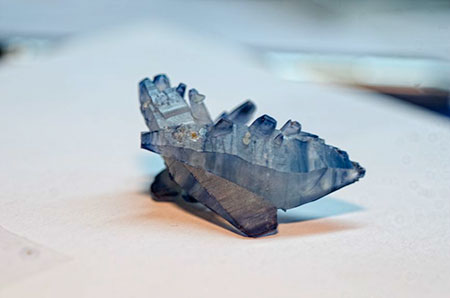 |
| Siamese twin? No, this spectacular twinned sapphire crystal comes from Ratnapura, Sri Lanka. It is included in a WSJ slide show in conjunction with “Secret Rocks.” (Photo: Richard W. Hughes) |
The article goes on to compare the tidiness of the global diamond trade with the unruliness of the colored gemstone business. The former is ruled by large companies like De Beers, the latter depends often on artisanal mining in obscure, far-flung climes, boomtowns rising and falling with the fleeting production of the newest find.
The article asks the question of whether change will come to the industry. You probably already know the answer, but if not, read to the end of “Secret Rocks.” [back to top]
 |
| Spinach blood. More than ruby hails from Burma. This 1.49-carat chrome kornerupine is summery and bright. Inv. #21006. (Photo: Mia Dixon) |
June 15 to 27 are the dates of what is being billed as the “50th anniversary” gems emporium to be held in Nay Pyi Taw, according to Eleven Media Group (EMG) on Sunday. The last emporium—the 49th “annual” (i.e., spring) sale—was held in March 2012. By our reckoning, no fall 2012 sale was held. The suspension likely was due to sales not being completed previously. In order to prevent such occurrences, jade bidder-buyers must deposit €20,000 (local) or €50,000 (foreign). For gems the deposits are €10,000 and €20,000, respectively.
Yesterday, EMG reported that merchants from Europe would attend the show for the first time. This development comes after the EU lifted the last of its sanctions, as reported by Mizzima News April 23, opening “a new chapter” with Burma.
This year, at least 10,000 jade lots will be offered. Last year, 9,762 jade lots were sold, bringing in $500 million out of total sales of jade, gems and pearls of $702.66 million.
Earlier this month, Burma hosted, for the first time, the International Gems Expo, in Yangon, according to EMG. The four-day show, beginning May 9, was to showcase over 40 companies from Burma, the U.S., Germany, Spain, Italy and Cambodia. A Myanmar Times story on May 6 stated that industry players were eager to obtain technical expertise from other countries. A follow-up story a week later stated that if Burma could keep ramp up a domestic jewelry industry, smuggling to China and Thailand might be avoided.
In other Burma news…
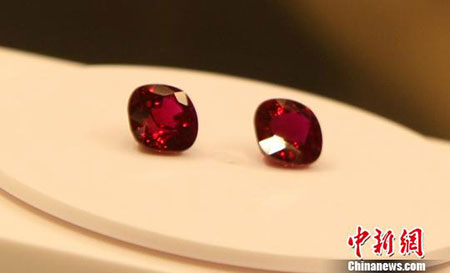 |
| Pigeon’s blood pair. With no context, this photograph appeared last week in People’s Daily Online, stating that the pair of Burma 6.27-carat Burma rubies, belonging to a private collector, were displayed in Nanjing. It’s possible it is the same pair of Burmese rubies mentioned in a Chinanews.com article about the 8th annual East China Premier Jewellery exhibition in Shanghai. The owner stated that the stones are worth “more than one billion yuan” ($120 million). (The People’s Daily article states “more than 100 million yuan,” or $12 million.) He displayed them for the first time because of his new confidence in the Chinese market for colored gemstones. |
[back to top]
With Pala Presents, we offer selections from the library of Pala International’s Bill Larson, who will share with us some of the wealth of information in the realm of gems and gemology.
 |
This article, from Swift, the inflight magazine of Asian Wings Airways, looks at pearl cultivation in Burma.
According to the article, Burma’s pearl cultivation remained largely unchanged until the mid 1950s, “when pearl production technology was introduced,” in a joint venture with a Japanese company. After nationalization in 1962, the Japanese were shunted aside, and technicians were brought in from such unlikely institutions as “the state-run pharmaceutical enterprise, Yangon University’s Department of Zoology and the Department of Medical Research”! Eventually private international companies were welcomed back in the 1990s, and remain involved in the industry today.
The article also takes the reader through the four-year process of cultivation, from mantle implantation to harvest. Read the article here. [back to top]
— End May Newsletter • Published 5/16/13 —
2015.3 | 2015.2 | 2015.1
2014.3 | 2014.2 | 2014.1 | 2013.3 | 2013.2 | 2013.1 | 2012.3 | 2012.2 | 2012.1
2011.3 | 2011.2 | 2011.1 | 2010.3 | 2010.2 | 2010.1 | 2009.3 | 2009.2 | 2009.1
2008.3 | 2008.2 | 2008.1 | 2007.3 | 2007.2 | 2007.1 | 2006.3 | 2006.2 | 2006.1
2005 | 2004 | 2003 | 2002 | 2001 | 2000
Note: Palagems.com selects much of its material in the interest of fostering a stimulating discourse on the topics of gems, gemology, and the gemstone industry. Therefore the opinions expressed here are not necessarily those held by the proprietors of Palagems.com. We welcome your feedback.